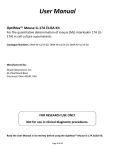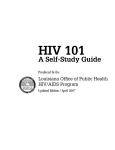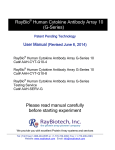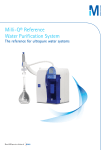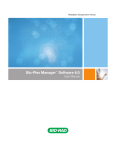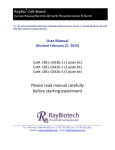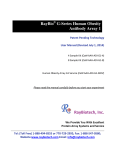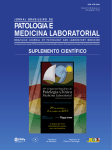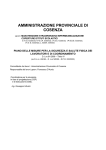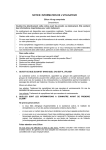Download Assay Tips - Abacus ALS
Transcript
The Power of Biomarker Analysis Multiplex assay tips from the makers of MILLIPLEX® map Merck Millipore is a division of Why just multiplex when you can MILLIPLEX®? For over ten years, Merck Millipore has offered the benefits of MILLIPLEX® map multiplexed assay panels—containing all the components and reagents you need to detect multiple analytes simultaneously. The benefits of multiplex protein detection assays are endless, but navigating a protocol can be challenging. We’re so confident in the benefits of MILLIPLEX® map kits that we’ve compiled this book of tips and tricks, straight from the experts, to eliminate any doubt in your ability to multiplex like a pro. Every year, thousands of your colleagues experience the benefits of MILLIPLEX® map kits, publishing in scientific journals around the world. We hope this guide enhances the power of your research with multiplexing. NOTE: Alternate methods presented in this guide may deviate from the protocol. These methods have either been tried by Merck Millipore or our end users using our MILLIPLEX® map kits. We cannot guarantee methods presented will work in all cases. These procedures have not been validated. Table of Contents Introduction Page 2 1 Page 4 2 Deciding Which MILLIPLEX® Assay is Best for Your Research Page 6 3 General Assay Information Page 8 4 Materials Required but Not Provided Page 10 5 Sample Collection and Preparation Page 12 6 Preparation of Reagents Page 15 7 Immunoassay Procedure Page 17 8 Plate Washing Page 18 9 Equipment Settings Page 20 10 MILLIPLEX® Analyst 5.1 Software Page 24 11 Data Analysis Page 27 12 Intracellular Assays Page 29 13 •The Luminex xMAP® Technology •MILLIPLEX® map: Bring your biomarkers to life Appendices 1: Species Cross-reactivity 2: Sample Preparation 3: Other Sample Types 4: Cell Signaling MAPmate™ Buffer Table 1 1 Introduction The Luminex xMAP® Technology: • MILLIPLEX® map is based on the Luminex xMAP® bead-based assay platform—one of the fastestgrowing and most respected multiplex technologies, supporting applications throughout the life sciences. This platform is capable of performing a variety of bioassays, including immunoassays, on the surface of fluorescent-coded magnetic (MagPlex®) and nonmagnetic (MicroPlex®) bead microspheres. • Merck Millipore provides three Luminex® instruments to acquire and analyze data using two detection methods (see Figure 1): • The Luminex 200™ and FLEXMAP 3D® systems are flow cytometry-based instruments that integrate key xMAP® detection components, such as lasers, optics, advanced fluidics and high-speed digital signal processors. • Luminex® uses proprietary techniques to internally color-code microspheres with multiple fluorescent dyes. Through precise concentrations of these dyes, distinctly colored bead sets of 500 5.6 µm non-magnetic or 80 6.45 μm magnetic polystyrene microspheres can be created, each of which is coated with a specific capture antibody. • The MAGPIX® analyzer is a CCD-based instrument that integrates key xMAP® capture and detection components with the speed and efficiency of magnetic bead processing. • After the target protein from a test sample is captured by the bead, a biotinylated detection antibody is introduced. • The reaction mixture is then incubated with Streptavidin-PE conjugate, the reporter molecule, to complete the reaction on the surface of each microsphere. • Each individual microsphere is identified by its “bead signature”, and the result of its bioassay is quantified based on fluorescent reporter signals. Merck Millipore combines the streamlined data acquisition power of Luminex® xPONENT® acquisition software with sophisticated analysis capabilities of the new MILLIPLEX® Analyst 5.1 software, integrating data acquisition and analysis seamlessly with all Luminex® instruments. The capability of adding multiple conjugated beads to each sample results in the ability to obtain multiple assay results from each sample. Open-architecture xMAP® technology enables the multiplexing of many types of bioassays, reducing time, labor and costs over traditional methods. Flow cytometry-based analysis Figure 1. Two different fluorescence detection methods for acquiring and analyzing beadbased assay data. LED-based analysis Monolayer beads Sheath fluid hydrodynamic focusing of sample Magnetic capture Interrogate bead with red laser (635 nm) Interrogate label with green laser (525 nm) 0.5 sec dwell time 10 msec dwell time Identify bead region based on internal dye concentrations 2 Quantify binding events Interrogate bead with red LED (635 nm) Identify and quantify with CCD imager Interrogate label with green LED (525 nm) Introduction MILLIPLEX® map: Bring your biomarkers to life MILLIPLEX® map kits offer multiplex detection of biomarkers in key research focus areas: • Bone Metabolism • Cancer Biomarkers • Cardiovascular Disease • Immunology/Immune Response • Intracellular - Cell Signaling - Cellular Metabolism • Metabolism/Endocrinology • Neuroscience • Toxicity Our kits offer: • The broadest selection of analytes across a wide range of disease states for both circulating and intracellular biomarkers. • All the components and reagents you need to detect multiple analytes simultaneously. • Quality controls provided to qualify assay performance. • Analytically validated panels yielding consistent analyte profiles within panels. • Comparison of standard and QC lots to a reference lot to ensure lot-to-lot consistency. • Panels that meet stringent manufacturing criteria to ensure batch-to-batch reproducibility. 3 Introduction 2 Deciding Which MILLIPLEX® Assay is Best for Your Research • Merck Millipore’s ELISAs and MILLIPLEX® assays for the same analyte commonly use the same antibody pairs and conditions. • In Method Comparison tests, while the or analyte: • Search the website for the catalog number. Links to some of the references using the absolute values are not exactly the same, the product can be found at the top of the results do correlate. Hence when switching Product Description page. from one assay platform to another, a correlation factor may be used when comparing with past data. In most situations the dynamic range and the sensitivity of the assay may be better with the MILLIPLEX® kits. • Please contact Technical Support for more information on correlation factors. • To locate protocols and technical documents for a specific panel: • Search the website for the catalog number. • For a more complete list, contact Technical Support. • To determine cross-reactivity for other species for a panel or analyte: • See the Species Cross-reactivity Tables in Appendix 1. • For intracellular assay kits, we analytically validate the assay with human cell/tissue culture samples. However, we provide the species homology for each analyte in a table • The link to the protocol can be found using: on the product detail page on our website. We - The “Documents” tab. have also compiled a list of this information - The right-hand side of the product name and catalog number. - The top of the Product Description page. • The easiest way to find a panel that contains the analytes you want to measure would be to search online: • The MILLIPLEX® Analyte Kit Finder located on the MILLIPLEX® home page. • Search the latest edition of the Analyte Quarterly: www.merckmillipore.com/milliplex 4 • To find publications citing a specific panel on our website: -Kits: Kit Species Cross Reactivity: www.merckmillipore.com/kits_species -MAPmate™ assays: MAPmate™ Species Cross Reactivity & Buffer Table: www.merckmillipore.com/mapmates_sp -Search the latest edition of the Analyte Quarterly: www.merckmillipore.com/milliplex Deciding on an Assay 5 3 General Assay Information • All kits are for Research Use Only. • How to design a “customized” kit: Deciding on an Assay Electrophoresis & Transfer • Select your panel of interest: for example, • Always read the entire protocol before proceeding. Human Cytokine/Chemokine Panel 1 (Cat. No. HCYTOMAG-60K). • For questions or issues with Luminex® instruments, contact Luminex® at: • All Regions: www.merckmillipore.com/lmx_contact • Technical Support: Phone: 512-381-4397 Toll-free: 1-877-785-2323 Fax: 512-219-5114 • Email: [email protected] • Choose only the analytes you want from that panel: for example, you may need only five analytes: IL-2, IL-6, IL-10, GM-CSF, VEGF-A. • Add the number of analytes you chose to the catalog number: HCYTOMAG-60K-05 and list the specific analytes. • How to design and order a customized kit online: • From the Product Description page: • For questions or issues with BioTek washers, contact BioTek at: • All Regions: www.merckmillipore.com/biotek_contact • Technical Support: In North America Call: (800) 242-4685 Outside the U.S. Call: (802) 655-4740 • Email: [email protected] -Click “Design & Purchase Your Own Kit”. -Make your choices; add to the cart and/or save to your favorites and go to “Checkout.” • From the MILLIPLEX® map website: www.merckmillipore.com/milliplex -Click “Design & Purchase Your Own Kit”. - Make your choices; add to the cart and/or save to your favorites and go to “Checkout.” • In “Quick Purchase”: -Click on the “Begin” icon located within “Design and Purchase your MILLIPLEX® map Kits.” • For questions or issues with MILLIPLEX® assays, please contact Merck Millipore Technical Support -Make your choices; add to the cart and/or save to your favorites and go to “Checkout.” or your Sales Specialist. • Do not use a kit beyond its expiration date. • The expiration date for a kit is that of the component with the shortest expiration date. This date is printed on the box label. • Kits will ship with a minimum of 3 months until expiration. • Longer expiration dates can be requested. Please contact your Sales Specialist. 6 General Information 7 4 Materials Required But Not Provided • Adjustable pipettes with tips capable of delivering 25 μL to 1000 μL. • Before you open a MILLIPLEX® map kit, check your instrument. • Is the instrument calibrated? • Multichannel pipettes capable of delivering 5 μL to • Has it been maintained? 50 μL or 25 μL to 200 μL. • Bead washer (either automated or manual): General Information • Laboratory vortex mixer. • Automated magnetic bead plate washers: - BioTek® 405 LS Magnetic 96-23ll Washer • Water bath sonicator (Branson Ultrasonic Cleaner Model #B200 or equivalent). • Sonicator probes are not recommended. (Cat. No. 40-0944). - BioTek® 405 LS Magnetic/Vacuum Filtration 96-well Washer (Cat. No. 40-095). - BioTek® 405 TS Magnetic 96-well Washer • Orbital titer plate shaker (Lab-Line Instruments Model #4625 or equivalent). • Very important: For incubating assays overnight a power supply must be available for the orbital shaker in a refrigerator or cold room. • The orbital titer plate shaker should be set at a speed to provide maximum orbital mixing without the splashing of liquid outside the wells. • For the recommended plate shaker, this would be a setting of 5-7, which is approximately 500-800 rpm. • Note that orbital shakers vary. Your shaker can be calibrated by pre-wetting the plate with Complete with Touch Screen and Ultrasonic Cleaning (Cat. No. 40-096). - BioTek® 405 TS Magnetic/Vacuum Filtration 96-well Washer Complete with Touch Screen and Ultrasonic Cleaning (Cat. No. 40-097). - Please see our Luminex® Technology Brochure (Lit. No. DS0012ENEU) for more information. • Handheld Magnetic Separator Block for 96-well Flat Bottom or Conical Well Plates (Cat. No. 40-285). buffer and slowly increasing the speed until splashing occurs. Then lower the speed slightly. The shaker should be set at the highest speed allowable without splashing the liquid. • Luminex 200™, MAGPIX®, or FLEXMAP 3D® analyzer instruments, available from Merck Millipore and manufactured by Luminex® Corporation. • Sheath fluid (Luminex 200™ or FLEXMAP 3D® systems) or drive fluid (MAGPIX® instrument) • Sheath fluid and drive fluid are specific for use in the appropriate instrument and cannot be used interchangeably. • Sheath fluid or drive fluid can be reordered directly from Merck Millipore: - Sheath Fluid (Cat. No. SHEATHFLUID) - MAGPIX® Drive Fluid 4PK (Cat. No. MPXDF-4PK) 8 BioTek® plate washer model 405 LS (top) and models 40-094 and 40-095 (bottom). 9 5 Sample Collection and Preparation General Information • Proper and consistent pipetting technique is • Tips on using tissue culture media as assay buffer: • If the medium used to grow the cells is used as the matrix, take care that there are no proteases key to consistent and accurate data, especially or any supplements that may interfere with if multiple users will be generating data in the assay or generate inaccurate results (e.g., collaboration. Improper or inconsistent technique cytokines, human serum, etc.). can affect delivery volumes and impact data reliability. Training or best practices for pipetting, including that pipettors are properly calibrated can substantially increase pipetting precision. • Some kits for metabolism biomarkers require adding protease inhibitors to samples. Others may require a sample extraction or acidification. For tips on proper pipetting techniques visit: • Consult the protocol of the appropriate kit. www.merckmillipore.com/mlo • See Sample Preparation outlines for kits requiring sample extraction, acidification, etc. in • Before you collect samples to run an assay, it’s Appendix 2. important to read the entire protocol. If you have any questions, contact Technical Support or your Sales Specialist. Preparation of Serum/Plasma Samples • For serum or plasma samples that require a dilution instead of “Neat”, use the serum matrix • If the protocol states that the kit can be used in provided in the kit as the diluents. either serum or plasma, and you have the option, choose serum because it tends to be cleaner. • Hemolysis can result in increased proteolytic activity and analyte degradation primarily due to • Be consistent with the use of sample types within enzymes released from lysed cells. a study/project. • Trace hemolysis in samples collected with protease • If you are trying to decide whether to collect serum or plasma samples, ask yourself what you have inhibitors may be acceptable, but gross hemolysis will probably interfere with assay performance. observed from preliminary data, publications or collaborators. • Still unsure? Contact Technical Support. • Freeze/thaw limits: • Multiple freeze/thaw cycles may reduce the stability of the analytes. • Hemoglobin (at >10 mg/mL) is known to interfere with antigen/antibody interactions. • If you want to run a MILLIPLEX® kit using samples other than serum or plasma, we have protocols to address tissue lysates, urine, blood spots, gingival fluid, nasal lavage fluid, tears, cerebrospinal fluid • Vortexing samples and beads: (CSF), bronchoalveolar fluid, saliva and cervical/ • To get a homogeneous prep, sample bead vaginal secretions, as well as protocols that are vortexing is recommended, especially after the sample has been centrifuged and the supernatant separated. 10 modified for use with small volume samples. • Please contact Technical Support or refer to Appendix 3. Preparation of Tissue Culture Supernatants • For cell culture supernatants or tissue extracts, use the culture or extraction medium as the matrix solution in the blank, standard curves and controls. - Note: to solubilize nuclear/mitochondrial proteins, you must use either SDS or another method (such as ultrasonication) to puncture the tough nuclear/mitochondrial membranes. • Reducing agents, like β-mercaptoethanol or dithiothreitol, are not recommended. • If samples are diluted in assay buffer, use the assay buffer as the matrix. • For more information about the compatibility of buffers with MILLIPLEX® map Signaling kits, contact • For cell/tissue homogenates, the final cell or tissue Technical Support. homogenate should be prepared in a buffer that has a neutral pH, contains minimal detergents or strongly denaturing agents and has an ionic • Perform all dilutions with lysis buffer (not assay buffer or phosphate-buffered saline (PBS)). strength close to physiological concentrations. • Avoid debris, lipids, and cell/tissue “aggregates.” Table 1. Detergent compatibility with MILLIPLEX® intracellular assays. • Centrifuge samples before use. • For adherent cell lines: seed ~40,000 cells/well and Ionic detergents allow growth for 48 hours. • For suspension cell lines: seed ~250,000 cells/well and collect at desired time. • For cell lysis: add 30 µL lysis buffer per well and pipet up and down thoroughly without creating Protein localization Cytoplasm Cytoplasm, Membrane-bound Membrane-bound, Nucleus, Mitochondria MILLIPLEX® assay compatibility Yes 5 mg/mL Yes 5 mg/mL Requires dilution Assay Preparation Preparation of Cell Lysates for Intracellular Assays in 96-well Plates Type of detergents Non-ionic detergents Partially ionic detergents Maximum allowed protein concentration 5 mg/mL • Total protein concentration limits*: • Do not collect lysates at greater than 5 mg/mL protein concentration. - At protein concentrations higher than 5 mg/mL, not all too many bubbles. For a more detailed protocol, proteins will be solubilized equally by the lysis buffer. request information from Technical Support. Some proteins can be solubilized at a given detergent concentration, while other proteins are not as affected. • Add protease inhibitors and/or phosphatase inhibitors to “home-brew” lysis buffers. For example, b-tubulin signal decreases with increasing total protein concentration (signal decrease occurs at 5 to 6 mg/mL for Jurkat cell and peripheral blood mononuclear • Lysis buffer selection: • Lysis buffer can be found in the Cell Signaling Buffer & Detection Kit (Cat. No. 48-602MAG) or sold separately (Cat. No. 43-040). • Non-ionic detergents (NP40, Tergitol, IPEGAL) are recommended in lysis buffers for solubilizing cytoplasmic proteins. • Partially ionic detergents (Triton® X-100) are recommended in lysis buffers for cytoplasmic or membrane-bound proteins. • Ionic detergents (sodium dodecyl sulfate, SDS) are recommended in lysis buffers for membrane-bound, nuclear or mitochondrial proteins. If using SDS in the lysis buffer (i.e., Radioimmunoprecipitation assay (RIPA) buffer), then cell lysate must be diluted to less than 0.05% SDS for assays to detect intracellular proteins, such as cell signaling proteins. cell (PBMC) lysates). • Total protein concentrations should be within a specific range, which is outlined in each protocol. - A starting protein amount is 10 µg per well (10 µg protein in the final 25 µL that is loaded into each assay well) is recommended. - Working backwards from there: - 10 µg/25 µL = 0.4 µg/µL (mg/mL). - Diluting the cell/tissue lysates 1:1 in the assay buffer provided in the intracellular kit is recommended. - Consequently, all samples need to be brought to a protein concentration of 0.8 µg/µL in lysis buffer. - Take 30 µL of each lysate sample and add it to 30 µL of assay buffer, bringing the final concentration down to 0.4 mg/mL. - Then load 25 µL of diluted samples into each well, usually in duplicate. *The Direct Detect® spectrometer enables you to determine protein sample concentrations quickly and accurately. For more information visit: www.merckmillipore.com/directdetect 11 6 Preparation of Reagents General Information Antibody-Immobilized Beads • Deliver extremely precise volumes of solvent when • The antibody-immobilized beads are light-sensitive reconstituting lyophilized products. Variations of even a few microliters will significantly affect quantitation. and must be protected from light at all times. • Cover the assay plate containing beads with an opaque plate lid or aluminum foil during all incubation steps. • Do not mix or substitute assay reagents with those from other lots or sources. • Any unused mixed antibody-immobilized beads may be stored in the Bead Mix Bottle at 2-8 °C for • If leftover reagent lots match and the reagents up to one month. have been kept at the appropriate storage conditions, they can be used in combination until the expiration dates. Standards • After hydration/reconstitution, all standards and Assay Preparation controls must be transferred to polypropylene • Serum matrix, bead diluents and wash and assay tubes. buffers from other kits can be used/combined if the catalog numbers of these components match in the protocols for the kits in question. Use of Bead Diluent • Approximately 10% of a normal population of • During the preparation of standard curves, thoroughly mix each higher concentration before making the next dilution. • Use a new pipette tip with each dilution. samples, especially human serum or plasma samples, has heterophillic antibodies that can nonspecifically bind to the capture and detection antibodies simultaneously, thus generating a false positive signal. • Bead diluents contain a cocktail of proprietary reagents that significantly reduce this false signal without reducing the true analyte measurement. • Bead diluents may also contain factors for detection (e.g., insulin in mouse kits). • The standards prepared by serial dilution must be used within one hour of preparation. • Discard any unused standards except the standard stock. • The standard stock can be stored at ≤ -20 °C for one month or at ≤ -80 °C for more than one month. Example of Standards Preparation 50 µL Standard • If assay buffer was erroneously added instead of bead diluent, transfer samples to a clean, clear centrifuge tube, spin down and remove buffer; 50 µL 100 µL 50 µL 100 µL 50 µL 100 µL 50 µL 100 µL 50 µL 100 µL 5 6 4 3 2 uted ard dard dard dard dard nstit 7 tand Stan Stan Stan Stan Reco andard S St • The quality of the standard curves can be determined by the % recovery of the standards and the QC values. 12 ard d Stan replace with bead diluents and proceed with the assay protocol. 100 µL 1 Quality Controls • We include Quality Controls (QCs) to qualify assay performance. • QC values are based on a minimum of six assays run by at least three different operators. The • Because blood is a complex matrix, which contains large numbers of proteins that may interfere with the accurate measurement of desired analytes, using an optimized serum matrix in the standard curves when measuring analytes secreted in serum/plasma: midpoint and +/- 35% of the high/low value • Significantly improves accuracy of measurement. (mean) are reported. • More accurately simulates the conditions of • When a customer contacts Technical Support with a concern related to assay performance, the the native analyte present in serum or plasma compared to a standard curve generated by customer is usually first asked if the QC values spiking an analyte into a buffer solution. are in a specific range. This tells the Technical • Mimics the environment of native analytes in Support Specialist whether or not the kit is serum or plasma. performing correctly. • Other commercial multiplex kits add a serum • Individual labs can qualify their own assay performance by including a high and low QC that may better reflect their unique experimental samples. matrix to sample wells. With some exceptions, we do not do this for the following reasons: • While this method does effectively show good recoveries, in most cases, adding serum matrix to sample wells can mask the matrix effect, likely • QCs are important for translational studies that require more validation, ensuring that the data are reproducible across various kit lots. • QCs are also important when comparing data for multi-site studies or to compare assay results from multiple technicians. Effect of Serum Matrix • If the recovery of analytes spiked into sample wells affecting the sensitivity of the actual analyte measurement. • It is very difficult to predict the effect of mixing serum matrix with samples from a randomly sampled population. • Kits designed for non-serum/plasma samples (e.g., urine, CSF) or samples that require a significant dilution (at least 1:20) do not require serum matrix. • For non-serum/plasma samples, the appropriate in an assay using a buffer standard curve falls medium (e.g., cell culture medium) should be outside our acceptance criteria (80% – 120%), this added instead of serum matrix. indicates that there is a nonspecific matrix effect from the samples. • To compensate for this effect, a serum matrix with a similar effect is added to the standard curve wells to shift the actual curve so that it matches the recovery in the sample wells. • Serum matrix is usually a similar sample with all the endogenous and cross-reacting analytes extracted. • In the absence of appropriate medium or when using a blank, assay buffer can be used. • For cell/tissue homogenates, the final cell or tissue homogenate should be prepared in a buffer that has a neutral pH, contains minimal detergents or strongly denaturing agents and has an ionic strength close to physiological concentrations. • An approximately 1:20 dilution would be required to eliminate the need for using serum matrix in an assay. 13 Enough Assay Buffer? Wash Buffer • Additional assay buffer that is required for samples • Incomplete washing can adversely affect the assay requiring higher dilutions may need to be ordered outcome. before running the assay. See Protocol sections “Reagents Supplied” or “Replacement Reagents” for the appropriate catalog number. • All washing must be performed with the wash buffer provided. • If more is required, see Protocol sections “Reagents Supplied” or “Replacement Reagents” for the appropriate catalog number. 14 Immunoassay Procedure 7 • Cover the plate with a plate sealer before shaking. Tips for Reducing Variability • Ensure proper sample collection. • The plate shaker speed should be increased to agitate the plate at the highest speed that does not lead to splashing on the sealer. • To avoid low bead counts, thaw, vortex and centrifuge all samples for 5-10 minutes at a minimum of 3,000 x g. Avoid or remove any fat layers that may develop. Immunoassay Procedure • Before running an assay, check the instrument the • Centrifuge samples after thawing or if they appear turbid. This is especially recommended for plasma samples. night before. • Is the instrument calibrated? • Has it been maintained? • Have fresh water prepared, calibrated and accurate pipettes, multichannel pipettes and an • Ensure the proper mixing of samples and controls. orbital shaker or alternative. • Confirm availability of a cold room or • Use appropriate pipetting technique: refrigerator with power access for the orbital • Hold the pipette at the same angle each time. shaker. • Use pipettes calibrated for values in the middle range (not extremes). • When running samples in duplicate, a maximum of 38 samples can be run per kit. Running Your Assay • Warm reagents to room temperature (20–25 °C) before mixing. For assays requiring overnight incubation in a cold room, warm reagents to room temperature on the second day as well. 2 3 A Standard 0 (Background) 1 Standard 4 QC-2 Control B Standard 0 (Background) Standard 4 QC-2 Control C Standard 1 Standard 5 Sample 1 D Standard 1 Standard 5 Sample 1 E Standard 2 Standard 6 Sample 2 F Standard 2 Standard 6 Sample 2 G Standard 3 QC-1 Control Etc. H Standard 3 QC-1 Control 4 5 6 7 8 9 10 11 12 96-Well Plate Map. Sample map showing placement of standards, QCs, background and samples. 15 • To pre-wet the plate, use 150 μL wash buffer or assay buffer. • If the detection antibody has been accidentally aspirated off or poured off before adding SAPE to the well, it is possible to recover the assay: • If you accidentally use wash buffer instead of assay buffer for your assay, and if sample has not yet been loaded, remove wash buffer and replace with assay buffer. • If sample has been added to the plate with wash buffer, there is a potential for low recovery as it may not have the required protein concentration or protease inhibitors. • Vortex all reagents well before adding them to the plate. • When using frozen samples, it is recommended to thaw the samples completely, mix well by vortexing at high setting and centrifuge at a minimum of 3000 x g prior to use in the assay to remove particulates. • Be precise when adding samples, standards and QCs to the plate. • Pipette to the sides of the wells. • Add 20 µL to 50 µL of detection antibody and continue to follow the protocol. • Replace the detection antibody cocktail volume with assay buffer, add SAPE and continue to follow the protocol. • If no detection antibody is available, add SAPE and continue to follow the protocol, keeping in mind that the signal may be lower. • The plate should be read immediately (within 4 hours) after the assay is finished. If the plate cannot be read immediately, seal the plate, cover with aluminum foil or an opaque lid and store the plate at 2-8 °C for up to 72 hours, with samples brought up in sheath/drive fluid. There may be a loss of sensitivity after 24 hours. • Before reading the plate, agitate the plate on the plate shaker at room temperature for 10 minutes. • Do not store processed samples in wash buffer. • Be sure all fluid is expressed out of the Running Your Assay pipette tips. • It is possible to run a portion of a plate initially, then reuse the plate with other samples later. • For incubating assays overnight, a power supply must be available for the orbital shaker in a refrigerator or cold room. • If the plate shaker has been turned off during the night, shake again at room temperature for one hour before proceeding with the assay protocol. • After overnight incubation of assays, remember to allow all reagents to warm to room temperature (20 °C – 25 °C) before use in the assay. • Cover the wells that are not being used. • Use precise volumes of reagents to ensure that enough remains to run the remaining wells at a later time. • Store reagents at appropriate conditions quickly after the first use (e.g., stock standard at -20 °C or lower). • Remake standards for subsequent batches. Be sure to run a standard curve for each batch. • When running subsequent batches, cover the previously used wells. • The mix of beads may be used for one month • Detection antibody cocktail and SAPE incubation if stored at 2-8 °C; stock standards should be times are critical. Do NOT exceed the dictated times stored at ≤ -20 °C for one month and at ≤ 80 °C as this will result in higher background signals. for more than one month. • If using the same plate, keep the plate very clean. Alternatively, use a second plate for the remaining samples. 16 Plate Washing 8 Tips for Reducing Variability • Orbital Titer Plate Shaker (Lab-Line Instruments Model #4625 or equivalent) • Very important: For incubating assays overnight, • Handheld Magnetic Separation Block (Merck Millipore Cat. No. 40-285) • When getting ready to decant the liquid from a power supply must be available for the orbital the plate, the plate MUST be firmly attached to shaker in a refrigerator or cold room. the magnet. • The orbital titer plate shaker should be set at a speed to provide maximum orbital mixing without splashing of liquid outside the wells. • For the recommended plate shaker, this would be a setting of 5-7, which is approximately 500800 rpm. • However, orbital shakers vary. Your shaker can be calibrated by pre-wetting the plate with • Grip the handheld separation block firmly. • During the wash steps, decant with a good shake while the plate is attached to the magnet over a sink. • When using a new magnet, check for space between the plate and magnet. Adjustments require a US Allen (hex) key to adjust the screws (not provided). buffer and slowly increasing the speed until splashing occurs. Then lower the speed slightly. The shaker should be set at the highest speed allowable without splashing of the liquid. 17 9 Equipment Settings FLEXMAP 3D® System Luminex® 100/200™ System • For the MAGPIX® system, choose the “enhanced MAGPIX® System • Use the manufacturer’s gate settings. startup” setting instead of the common startup. • This will ensure proper calibration and cleaning prior to running the assay. • Working with serum is “dirtier” than other samples and can affect the performance of the instrument unless it is properly cleaned. • Luminex® can provide a recommended protocol for maintenance. • The Luminex 200™ system’s xPONENT® 3.1 acquisition software has two functions: one for magnetic (MagPlex®) and one for nonmagnetic beads (MicroPlex®). • Be sure to select the correct setting in the protocol for your bead type. • If the wrong type is selected, the plate does not need to be reread. The batch can be replayed • Be sure the needle probe is clean. This may be achieved by sonication and/or alcohol flushes. with the corrected protocol setting. • The link for xPONENT® software templates: • www.merckmillipore.com/lmx_xponent • Probe height: • When reading an assay on a Luminex 200™ instrument, adjust the probe height according to the protocols recommended by Luminex® to the (Life Science Research → Protein Detection and Quantification → Luminex® Multiplexing Instruments → Multiplex Assay Analysis Software → xPONENT® kit solid plate using 3 alignment discs. • When reading an assay on a FLEXMAP 3D® • If a plate cannot be run immediately (within 4 system, adjust probe height according to the hours) (e.g., it needs to be taken to another site to protocols recommended by Luminex® to the kit run the assay), suspend your sample in sheath or solid plate using 1 alignment disc. drive fluid or assay buffer. • When reading an assay on a MAGPIX® system, adjust the probe height according to the protocols recommended by Luminex® to the kit solid plate using 2 alignment discs. • Annotating control wells on the instrument can be tedious, with a lot of manual typing. • It is possible to enter the wells as unknowns instead of controls to avoid typing in the annotations for controls, then comparing with your chart later. 18 • 10-12 plates can be run with one bottle of drive fluid for the MAGPIX® system. • To change a standard curve from, for example, a 7-point curve to an 8-point curve, simply make a new protocol and replay the batch. Running MILLIPLEX® map Kits on Other Luminex® Instruments Overview of Instrument Considerations During a MILLIPLEX® map Assay • A Luminex 100™ system with IS software, Starting up and shutting down your system correctly Luminex 200™, FLEXMAP 3D® or MAGPIX® will ensure its longevity. The instructions for the instrument is required to run a MILLIPLEX® map MAPGIX® and Luminex 200™ systems are located assay. within the systems user manual*. Short-term • If you want to try a kit before purchasing an cleaning will prevent sample induced clogging, while instrument, ask your Sales Specialist to provide long-term cleaning is important to ensure that drive a demonstration using the Luminex® technology fluid does not evaporate and crystallize. and MILLIPLEX® map kits. • Magnetic bead assays cannot be run on any instruments using Luminex® IS 2.3 or Luminex® 1.7 software. Preparation • Check probe and insert into reader; set probe height. • Fill reservoirs (Milli-Q® water, 70% EtOH, • Since all Luminex® machines (Luminex 200™, FLEXMAP 3D® and MAGPIX® instruments) are built by the Luminex Corporation, MILLIPLEX® map kits can be run on any of these machines, regardless of the name given to the machine by a Luminex® business partner. • If using Luminex® instruments with software other than xPONENT® software (Bio-Plex Manager™, MasterPlex®, STarStation, LiquiChip, LABScan™ 100) , follow instrument instructions for gate settings and additional specifications from the software vendors for reading assays using Luminex® magnetic beads. 0.1M NaOH). • Revive instrument: revive from storage, daily start-up. • Calibrate and verify instrument: system installation. • Read the entire kit protocol. • Acquire “Materials Required But Not Supplied.” • Confirm accuracy of pipettes. Assay • Follow the kit protocol. • Set up experimental design on acquisition software. • Run assay. • Run “Post Batch Routine.” • To read a MILLIPLEX® map kit on a Bio-Plex® Shutdown depending on the version of Bio-Plex Manager™ • Daily shutdown (overnight): software. • Run “Clean Routine”. Acquisition & Analysis of Data machine, select 5K-25K for magnetic beads, • Run “Daily Shutdown Routine”. • Remove probe and clean in a sonicating water bath. • Long-term shutdown (longer than one week): • Run “Clean Routine” multiple times. • Run “Prepare for Storage” part 1. • Prime multiple times with Milli-Q® water (use an empty sheath fluid container). • Run “Prepare for Storage” part 2. • Remove probe and clean in a sonicating water bath. * Luminex 200™ User Manual, Section 3, page 17. MAGPIX® User Quick Guide 4.2 19 10 MILLIPLEX® Analyst 5.1 Software Merck Millipore offers the most powerful combination software package, including best-in-class multiplex data analysis MILLIPLEX® Analyst 5.1 software coupled with data acquisition using the Luminex xPONENT® software. MILLIPLEX® Analyst 5.1 software enables you to manage, track and analyze your multiplex assays rapidly and efficiently, giving you more time to focus on advancing your research. Data acquisition and analysis integrates seamlessly with all Luminex® instruments, including FLEXMAP 3D®, Luminex 200™ and MAGPIX® systems. MILLIPLEX® Analyst 5.1 software is available in one- and five-seat licenses, enabling complete flexibility for small, medium and large laboratories. Step 1: Acquisition & Analysis of Data Choose the folder containing the exported data files. 20 Step 2: Select the appropriate File Type from the pull-down menu: • CSV Files (*.csv) from xPONENT® software. • Excel® files (*xls) from Bio-Plex® software. 21 Step 3: Importing data from xPONENT® software using Auto Detect Curve: • Set Auto Detect Curve to STD and highlight the file (auto detect.csv). • Press the green arrow/icon. • Loaded files are shown in the File Names window. • The Standard Curve settings will be ignored and the software will use the Standard Curves as set up in xPONENT® software. • Click “Next” to continue to the Plate Map screen. 22 Step 4: Importing Data from xPONENT® software using Auto Detect Curve – Plate Map: • Assign analytes, dilutions and sample names as needed. • If the kit and Plate Layout will be used again, save as a “Protocol”. • When ready for Analysis, click “Next”. Step 5: Data Analysis with MILLIPLEX® Analyst 5.1 software: • Concentration of each analyte is calculated in pg/mL using the Standard Curve. • Best Fitting is a 5-P log curve fitting algorithm. • Click on different analytes to see where that sample is on the Standard Curve. • All graphs are updated in real time. • Detailed Reports can be saved as an Excel® file. 23 11 Data Analysis Bead Counts • Merck Millipore recommends counting 50 beads. • According to Luminex®, a minimum of 35 beads per region need to be counted. • When using a handheld magnet, blot the plate gently. • When using a plate washer, check the settings to make sure the plate is soaking for 60 seconds and the aspiration is not all the way down in the well. • Fewer than 35 beads could cause a shift in the MFI (Median Fluorescence Intensity) value of the bead population. • However, MFI will not change for bead counts greater than or equal to 35. • Therefore, don’t worry if there is a 35 bead count on one bead region and 400 for others. MFIs will not be affected. ow to Correct or Prevent Low H Bead Counts • Be sure to specify MagPlex® in the kit protocol for xPONENT® software or use the correct gate setting on Bio-Plex® software. • Warm the plate to room temperature after an overnight 4 °C capture antibody incubation step. Let the plate shake at room temperature for one hour. • For MAGPIX® users, cleaning the instrument is critical. • Special care should be taken to use the enhanced startup or washing procedures. • There is an advanced cleaning method that includes sodium hydroxide (NaOH) and bleach. • Washing between wells can also be selected during the plate reading. • Cleaning the instrument regularly is important • Sample preparation: Thaw, vortex and centrifuge samples at a minimum of 3,000 x g. Avoid or remove any fat layers that may develop. • For samples known to be challenging (e.g., synovial fluid, saliva), one may increase wash steps after even if the instrument is not being used. Percent Coefficient of Variation (%CV) • High %CVs for standards or samples can be due to bead count. incubation with primary antibody. • For assays that have a standard curve, our target • Resuspend beads in wash buffer instead of sheath/ drive fluid. However, the plate must be read within inter-assay %CV is <15% and our target intraassay %CV is <10%. four hours. • For qualitative assays (no standard curves) the MFI • Add 1x wash buffer, which contains Tween® 20, to keep the beads from clumping or sticking. • Store only in sheath or drive fluid. 24 target inter-assay %CV is <20% and the target intra-assay %CV is <15%. Calculating Lower Limit of Quantification (LLOQ) and Upper Limit of Quantification (ULOQ) • Defining LLOQ and ULOQ requires a tight standard Recovery • Percent recovery should be 100% +/- 30% (industry minimum), although some customers will have their own acceptance criteria. curve (e.g., a 1:2 or 1:3 serial dilution to the point that you achieve saturation at both ends). • Percent recovery is usually worse at either extreme of the curve, but this also improves with time and • Choose the lowest and highest standard curve points that have a recovery of +/- 20%. practice. • For curve statistics, focus on the R2 value, which approach, but never equal unity. (Note that a R2 • Verify that this is the LLOQ and ULOQ by running 5 assays with the LLOQ and ULOQ as samples against value of “1” is seen with software rounding of 0.9999). a curve using the assay serial dilution factor where the lowest standard is below LLOQ and the highest standard is above ULOQ. inimum/Maximum Detectable M Concentration (minDC/maxDC) • For many assays, the minDC/maxDC will be outside • Inter-assay precision should be within 20% for LLOQ and ULOQ samples. Curve Performance/Fit • Standard point %CVs should be <15%. • High %CVs here indicate improper technique was used when making standard curve dilutions. Examples of poor technique include: • Not vortexing between tubes. • Not vortexing while loading the plate. • Not pipetting equal amounts into the plate. - The lower the concentrations of analytes, the higher the %CVs tend to be. With new users, this improves with time and practice. - For any standard points that have high %CVs, samples in that range of the curve should be interpreted with caution. - Alternatively, a standard point or one of the replicate wells can be flagged/masked, although it can be difficult to decide which well to flag if only duplicates are run. the standard points (extrapolated) due to good curve performance and fit. • To avoid seeing extrapolated data, set the desired range of detection in MILLIPLEX® Analyst 5.1 software. • Deciding whether to use the “Best Fit” vs. 5-parameter lot option depends on your comfort level to determine how appropriate it is to “play” with curve fit to find the best one. • If samples fall outside the dynamic range of the assay, dilute the samples further with the appropriate matrices/media and repeat the assay. How Merck Millipore Monitors/ Avoids Lot-to-lot Drift • Lot-to-lot drift is monitored and mitigated using full-curve comparison and comparing the relative potency of each analyte against a reference lot. • All data are compiled in a single database, and trend charts are maintained in our records. • MILLIPLEX® map standard points maintain consistent values from lot to lot, unlike other kits that may have values that vary lot to lot. 25 Comparison of MILLIPLEX® Analyst 5.1, StatLIA and Bio-Plex® Analysis Software Analyte: IFNγ, Kit: Rat Cytokine/Chemokine Units: pg/mL Green: Extrapolated value Orange: Extrapolated value MILLIPLEX® Analyst 5.1* StatLIA® Standard1 14.7 3.0 Standard2 57.4 67.0 Bio-Plex® 53.7 Standard3 241.6 245.0 248.6 Standard4 932.1 897.0 908.1 Standard5 3683.0 3858.0 3820.0 Standard6 15184.0 14769.0 14824.5 60975.2 Standard7 59874.0 61392.0 Unknown1 <3.40↓ <1.0e-07 OOR < Unknown2 16.8 8.0 OOR < Unknown3 51.3 60.0 45.0 Unknown4 197.1 205.0 205.8 Unknown5 844.1 809.0 821.3 Unknown6 3412.0 3564.0 3531.3 Unknown7 14639.0 14296.0 14339.3 Unknown8 70718.0 82002.0 78697.5 Unknown9 <3.40↓ <1.0e-07 OOR < Unknown10 <3.40↓ <1.0e-07 OOR < Unknown11 <3.40↓ <1.0e-07 OOR < Unknown12 3.7 <1.0e-07 OOR < Unknown13 <3.40↓ <1.0e-07 OOR < Unknown14 <3.40↓ <1.0e-07 OOR < Unknown15 5.0 <1.0e-07 OOR < Unknown16 16.8 8.0 OOR < Unknown17 24.0 22.0 OOR < Unknown18 28.6 29.0 1.1 Unknown19 <3.40↓ <1.0e-07 OOR < Unknown20 <3.40↓ <1.0e-07 OOR < Unknown21 <3.40↓ <1.0e-07 OOR < Unknown22 14.7 3.0 OOR < Unknown23 <3.40↓ <1.0e-07 OOR < Unknown24 <3.40↓ <1.0e-07 OOR < Unknown25 6.8 <1.0e-07 OOR < Unknown26 <3.40↓ <1.0e-07 OOR < Unknown27 <3.40↓ <1.0e-07 OOR < Unknown28 5.9 <1.0e-07 OOR < Out of Range Below Unknown29 4.5 <1.0e-07 OOR < <3.40↓: Out of Range Below Unknown30 8.2 <1.0e-07 OOR < <1.0e-07: Out of Range Below Unknown31 <3.40↓ <1.0e-07 OOR < *Best Fitting, 5P Log Unknown32 <3.40↓ <1.0e-07 OOR < OOR<: Table 2. Significantly more IFNγ concentrations could be calculated at the low end of the curve in the Rat Cytokine/Chemokine Magnetic Bead Panel by MILLIPLEX® Analyst 5.1 software compared to the Bio-Plex® and StatLIA® software packages. 26 Intracellular Assays 12 Differences between multiplex assays for circulating analytes vs. intracellular analytes Circulating Analyte Assay Intracellular Analyte Assay Quantitative Qualitative (fold change) Serum, plasma, tissue culture, urine, CSF, etc. Cells must be lysed Analytes analytically validated within panel Fixed kits and individual MAPmates™ are analytically validated Kit includes standards and QCs Kits and MAPmate™ assays include positive and negative control cell lysates Most panels are customizable Kits are fixed; create custom kits by combining Cell Signaling MAPmate™ assays Using Cell Signaling MAPmate™ Assays • All magnetic MAPmate™ assays require the Cell Signaling Buffer & Detection Kit (Cat. No. 48-602MAG). • This kit contains all necessary reagents except the MAPmate™ assays. Both a filter and flatbottom plate are included for convenience. • The following MAPmate™ assays should not be plexed together: • Phospho-specific and total MAPmate™ pairs (e.g., total GSK3β and phospho-GSK3β (Ser9)). • Pan Tyr and site-specific MAPmate™ assays (e.g., phospho-EGF Receptor (pan Tyr) and phospho-STAT1 (Tyr701)). • More than 1 phospho-specific MAPmate™ assay for a single target (e.g., pAkt (Ser473) and pAkt (Thr308)). • To select the appropriate buffer for your MAPmate™ assays, please refer to the protocols or the buffer selection tables on the website, in the Analyte Quarterly or Appendix 5. www.merckmillipore.com/cellsignaling_assays “Plexing” Cell Signaling MAPmate™ Assays • Up to eight MAPmate™ assays (single plex) and the Cell Signaling Buffer and Detection kit can be combined into a custom multiplex kit. • Refer to the guidelines provided in the MAPmate™ protocol. intracellular assay kits to enhance the panel or serve as controls. • Refer to the guidelines provided in the kit protocol. with kits or MAPmate™ assays containing pan Tyr assays. Preparation of Cell Lysates for Intracellular Assays • 96-well plates: • For adherent cell lines: seed ~40,000 cells/well and allow growth for 48 hours. • For suspension cell lines: seed ~250,000 cells/ well and collect at desired time. • For cell lysis: add 30 µL lysis buffer per well and pipet up and down thoroughly without creating too many bubbles. For a more detailed protocol, request info from Technical Support. Intracellular Assays • MAPmate™ assays can also be added to existing • GAPDH and β-Tubulin assays cannot be plexed - Unbroken cells/parts can be cleared by either filtration or by centrifugation. • Add protease inhibitors and/or phosphatase inhibitors to “home-brew” lysis buffers. 27 • Lysis buffer can be found in the Cell Signaling Buffer & Detection Kit (Cat. No. 48-602MAG) or it is sold separately (Cat. No. 43-040). • Total protein concentration limits: • Do not collect lysates at greater than 5 mg/mL protein concentration. - At protein concentrations higher than 5 mg/mL, not all proteins will be solubilized • Other lysis buffer selections: • Non-ionic detergents (NP40, Tergitol, IPEGAL) are recommended in lysis buffers for solubilizing cytoplasmic proteins. • Partially ionic detergents (Triton® X-100) are recommended in lysis buffers for cytoplasmic or membrane-bound proteins. • Ionic detergents (sodium dodecyl sulfate, SDS) are recommended in lysis buffers for membrane-bound, nuclear or mitochondrial proteins. If using SDS in the lysis buffer (i.e., Radioimmunoprecipitation assay (RIPA) buffer), then cell lysate must be diluted to less than 0.05% SDS for assays to detect intracellular proteins, such as cell signaling proteins. - Note: to solubilize nuclear/mitochondrial proteins, you must use either SDS or another method (such as ultrasonication) to puncture the tough nuclear/mitochondrial membranes. • Reducing agents, like β-mercaptoethanol or dithiothreitol, are not recommended. concentration, while other proteins are not as affected. For example, b-tubulin signal decreases with increasing total protein concentration (signal decrease occurs at 5 to 6 mg/mL for Jurkat cell and peripheral blood mononuclear cell (PBMC) lysates). • Total protein concentrations should be within a specific range, which is outlined in each protocol. - A starting protein amount is 10 µg per well (10 µg protein in the final 25 µL that is loaded into each assay well) is recommended. - Working backwards from there: - 10 µg/25 µL = 0.4 µg/µL (mg/mL) - Diluting the cell/tissue lysates 1:1 in the assay buffer provided in the intracellular kit is recommended. - Consequently, all samples need to be brought to a protein concentration of Type of detergents Protein localization Non-ionic detergents Cytoplasm 5 mg/mL Yes to 30 µL of assay buffer, bringing the final Partially ionic detergents Cytoplasm, Membrane-bound 5 mg/mL Yes concentration down to 0.4 mg/mL. Ionic detergents Membrane-bound, Nucleus, Mitochondria 5 mg/mL Luminex® assay compatibility 0.8 µg/µL in lysis buffer. - Take 30 µL of each lysate sample and add it - Then load 25 µL of diluted samples into Requires dilution buffer or phosphate-buffered saline (PBS)). Intracellular Assays can be solubilized at a given detergent Maximum allowed protein concentration • Perform all dilutions with lysis buffer (not assay 28 equally by the lysis buffer. Some proteins each well, usually in duplicate. Appendix 1: Species Cross-reactivity 13 Canine • Four serum or plasma samples were usually run in each kit. Exceptions are noted. • Data below are the number of samples that showed signal above background. • For more information contact Technical Support. Cytokine kits Panel Name Human Cytokine/Chemokine Panel 1 EGF Eotaxin FGF-2 Fractalkine G-CSF GM-CSF GRO IFNα2 4 2 1 1 1 1 1 1 IFNg IL-1α IL-1β IL-1ra IL-2 IL-3 IL-5 IL-6 1 2 3 2 2 2 1 1 IL-7 IL-8 IL-9 IL-10 IL-12(p40) IL-13 IL-15 IL-17A 1 2 2 1 TGFα 2 1 1 1 2 IP-10 MCP-1 MCP-3 MDC MIP-1α MIP-1β sCD40L 1 1 2 2 2 1 2 TNFα TNFβ VEGF-A PDGF-AB/BB 0 2 1 3 CTACK IL-23 TPO TSLP IL-33 1 1 1 2 1 1 1 Panel Name IL-17F GM-CSF IL-10 MIP3α IL-15 IL-17A IL-22 Human TH17 1 4 3 1 3 1 3 3 IL-1β IL-33 IL-2 IL-4 IL-23 IL-17E IL-27 IL-31 3 1 3 3 3 1 2 1 GM-CSF sCD137 IL-10 IL-13 Granzyme B IL-2 IL-4 MIP-1α 1 2 1 1 1 4 1 1 GM-CSF IFNγ IL-10 IL-13 IL-17A IL-1β IL-2 IL-4 2 1 3 1 2 1 1 3 IL-23 IL-7 IL-8 MIP1α MIP1β 3 1 3 2 1 Eotaxin G-CSF GM-CSF IFNγ IL-1α M-CSF IL-1β IL-2 4 1 4 3 2 4 4 2 IL-3 IL-4 IL-5 IL-7 IL-10 IL-12(p40) IL-13 IL-15 2 1 3 3 1 1 3 2 IL-17A IP-10 MIP-2 KC LIF LIX MCP-1 MIP-1α 2 4 2 4 2 4 4 4 MIP-1β MIG RANTES TNFα IL-12(p70) VEGF-A IL-9 1 3 3 4 2 4 3 Panel Name Human Cytokine/Chemokine Panel 2 SDF-1α+β EOTAXIN-3 IL-9 TNFβ 3 Panel Name Human CD8+ MIP-1β 1 Panel Name Human High Sensitivity T Cell Panel Name Mouse Cytokine/Chemokine Panel 1 Appendices 29 Cytokine kits (continued) Panel Name GM-CSF IFNβ MIP-3α IL-1b IL-2 IL-4 IL-5 IL-6 Mouse TH17 4 3 1 2 3 1 1 1 IL-21 IL-22 IL-28B IL-10 IL-23 IL-12(p70) IL-27 IL-13 4 4 3 2 1 1 0 2 IL-15 IL-17F IL-33 IL-31 TNFb TNFα sCD40L 4 4 4 1 4 3 4 GM-CSF TGFα G-CSF IFNγ IL-2 IL-10 IL-15 sCD40L 1 4 3 2 4 0 2 1 IL-17A IL1ra IL-13 IL-1β IL-4 IL-5 IL-6 IL-8 4 3 0 2 2 4 2 1 MIP-1α TNFα IL-12 VEGF-A IL-18 1 3 1 4 2 G-CSF Eotaxin GM-CSF IL-1α Leptin MIP-1α IL-1β IL-2 1 1 3 2 4 4 4 4 IL-6 EGF IL-13 IL-10 IL-12(p70) IFNγ IL-17A IL-18 2 4 3 4 2 2 1 4 MCP-1 IP-10 GROα/KC VEGF-A Fractalkine LIX MIP-2 TNFα 3 4 3 4 4 4 3 2 IL-1α IL-1β IL-1ra IL-2 IL-4 IL-6 IL-10 IL-12 1 4 4 4 4 2 4 4 Panel Name Non-Human Primate Cytokine/ Chemokine Panel Name Rat Cytokine/Chemokine RANTES 1 Panel Name Porcine Cytokine/Chemokine IL-18 4 Cardiovascular Disease (CVD) kits Panel Name NT proBNP CK-MB CXCL6 Endocan-1 FABP4 LIGHT Oncostatin Troponin-I 4 4 1 1 1 1 1 1 ADAMTS13 D-Dimer FABP5 GDF-15 Myoglobin sP-Selectin sVCAM-1 SAA 4 3 4 4 3 4 3 1 Human CVD1 Panel Name Human CVD2 Panel Name α-2Macroglobulin AGP Fibrinogen sL-Selectin Haptoglobin Platelet Factor 4 von Willebrand Factor 4 3 1 4 4 2 4 Human CVD3 Panel Name Follistatin dPAPP-A sPECAM-1 Pentraxin-3 Tissue Factor Thrombomodulin Troponin T 3 4 2 4 1 1 3 Human CVD4 Panel Name MMP-9 Mouse CVD1 1 Angiogenesis kits: 8 samples run Appendices Panel Name Human Angiogenesis/ Growth Factor 30 EGF ANGPT-2 Leptin FGF-1 IL-8 HGF HB-EGF VEGF-C VEGF-D FGF-2 VEGF-A 3 8 1 8 1 2 8 2 6 2 2 Feline • Four serum or plasma samples were usually run in each kit. Exceptions are noted. • Data below are the number of samples that showed signal above background. • For more information contact Technical Support. Cytokine kits Panel Name Human Cytokine/Chemokine Panel 1 EGF Eotaxin FGF-2 FIt-3L Fractalkine G-CSF GRO IFNα2 1 1 1 1 2 2 2 2 IFNg IL-1α IL-1β IL-1ra IL-2 IL-3 IL-5 IL-6 1 2 3 2 2 2 1 1 IL-7 IL-8 IL-9 IL-10 IL-12(p40) IL-13 IL-15 IL-17A 1 1 1 2 1 2 2 1 IP-10 MCP-1 MCP-3 MDC MIP-1α MIP-1β sCD40L TGFα 1 1 2 2 2 1 2 2 TNFα TNFβ VEGF-A PDGF-AB/BB 0 2 1 3 SDF-1α+β I-309 IL-23 TPO IL-33 Human Cytokine/Chemokine Panel 2 3 1 3 2 3 Panel Name GM-CSF IL-2 MIP-1α Perforin 1 2 1 1 Panel Name Human CD8+ Panel Name IL-17E GM-CSF MIP-3α IL-1b IL-2 IL-4 IL-5 IL-21 Human TH17 3 3 1 1 1 2 2 3 IL-22 IL-28B IL-10 IL-23 IL-12(p70) 4 4 3 2 4 GM-CSF TGFα G-CSF IFNγ IL-2 IL-15 IL-17A IL-1ra 1 3 3 2 3 1 2 3 IL-13 IL-1β IL-4 IL-5 IL-6 IL-8 MIP-1α TNFα 2 3 3 3 2 3 1 2 MIP-1β IL-12/23 (p40) VEGF-A Fractalkine LIX MIP-2 TNFα RANTES 0 1 3 4 4 4 2 2 G-CSF Eotaxin GM-CSF IL-1α Leptin MIP-1a IL-4 IL-1β 2 3 4 3 4 4 3 4 IL-2 IL-6 EGF IL-13 IL-10 IL-12(p70) IFNγ IL-5 3 2 2 Panel Name Non-Human Primate Cytokine/ Chemokine Panel Name Rat Cytokine/Chemokine Panel Name Canine Cytokine/Chemokine Panel Name Porcine Cytokine/Chemokine 3 2 4 2 4 IL-17A IL-18 MCP-1 IP-10 GROα/KC 2 3 3 4 4 GM-CSF IFNγ IL-2 IL-6 IL-7 IL-8 IL-15 IP-10 4 2 4 4 3 1 3 3 KC-like IL-10 IL-18 MCP-1 TNFα 3 1 4 4 1 GM-CSF IL-1α 1 1 31 CVD kits Panel Name FABP3 FABP4 Troponin-I 3 1 4 Human CVD1 Panel Name ADAMTS13 FABP5 GDF-15 Myoglobin sP-Selectin 4 4 4 4 1 Human CVD2 Panel Name Human CVD3 α-2Macroglobulin AGP sL-Selectin SAP Haptoglobin Platelet Factor 4 von Willebrand Factor 4 1 4 1 3 1 4 Panel Name dPAPP-A Tissue Factor 2 1 Panel Name MMP-9 sP-Selectin Mouse CVD1 1 4 Human CVD4 Angiogenesis kits: 6 samples run Panel Name Human Angiogenesis/ Growth Factor EGF G-CSF ET-1 FGF-1 Follistatin HB-EGF VEGF-A 5 2 1 5 3 5 2 Guinea Pig • Four serum or plasma samples were usually run in each kit. Exceptions are noted. • Data below are the number of samples that showed signal above background. • For more information contact Technical Support. Cytokine kits Panel Name EGF IL-3 MDC 1 2 4 SDF-1α+β BCA-1 IL-16 4 1 1 Panel Name GM-CSF MIP3α Human TH17 4 3 Panel Name IL-2 Human Cytokine/Chemokine Panel 1 Panel Name Human Cytokine/Chemokine Panel 2 Human CD8+ Panel Name Mouse Cytokine/Chemokine Panel 1 Panel Name Human CD8+ 32 1 Eotaxin IFNγ IL-1β IL-12(p40) IL-13 IL-15 IL-17A IP-10 2 2 2 4 4 1 1 4 MIP-2 LIX RANTES 4 4 2 Cytokine kits (continued) Panel Name IL-17E GM-CSF IFNγ IL-2 IL-4 IL-5 IL-22 IL-28B Mouse TH17 4 3 4 2 1 4 4 4 IL-10 IL-23 IL-12(p70) IL-15 IL-17A IL-17F IL-33 TNFb 1 4 4 2 4 1 4 2 GM-CSF G-CSF IL-2 VEGF-A 1 4 4 2 Eotaxin GM-CSF IL-1α Leptin IL-4 IL-1β IL-2 IL-6 1 2 2 4 3 4 2 1 IL-13 IL-10 IL-12(p70) IL-18 MCP-1 IP-10 GROα/KC VEGF-A 2 4 1 1 3 2 2 2 LIX MIP-2 TNFα RANTES 4 4 2 2 GM-CSF IL-15 IP-10 IL-18 4 1 4 2 GM-CSF IL-1β IL-1ra IL-2 IL-4 IL-6 IL-10 IL-12 3 4 1 2 3 1 1 2 sCD40L 3 Panel Name Non-Human Primate Cytokine/ Chemokine Panel Name Rat Cytokine/Chemokine Panel Name Canine Cytokine/Chemokine Panel Name Porcine Cytokine/Chemokine IL-18 2 CVD kits Panel Name ADAMTS13 D-Dimer FABP5 GDF-15 Myoglobin sP-Selectin 4 3 4 4 3 1 AGP Haptoglobin von Willebrand Factor 2 4 4 Panel Name MMP-9 PAI-1 (total) sP-Selectin Mouse CVD1 2 3 3 Human CVD2 Panel Name Human CVD3 Angiogenesis kits: 6 samples run Panel Name Human Angiogenesis/Growth Factor ANGPT-2 BMP-9 FGF-1 Follistatin HB-EGF 5 4 1 5 5 33 Hamster • Four serum or plasma samples were usually run in each kit. Exceptions are noted. • Data below are the number of samples that showed signal above background. • For more information contact Technical Support. Cytokine kits Panel Name FGF-2 Fractalkine IL-1α IL-3 MIP-1β PDGF-AA 2 1 3 1 4 1 1 SDF-1α+β CTACK IL-21 4 1 1 Panel Name GM-CSF MIP3a IL-13 TNF-a Human TH17 4 1 4 4 Panel Name G-CSF GM-CSF IFNγ IL-1α M-CSF IL-7 IL-12(p40) IL-13 1 1 2 1 1 1 1 4 IL-15 IL-17A IP-10 LIX MIP-1α MIP-1β MIG RANTES 2 1 1 1 1 2 2 3 IL-12(p70) VEGF-A IL-9 1 4 3 IL-17E GM-CSF IFNγ IL-2 IL-4 IL-5 IL-6 IL-21 Human Cytokine/Chemokine Panel 1 Panel Name Human Cytokine/Chemokine Panel 2 Mouse Cytokine/Chemokine Panel 1 Panel Name Mouse TH17 Panel Panel Name Rat Cytokine/Chemokine Panel Name Porcine Cytokine/Chemokine Panel Name Non-Human Primate Cytokine/ Chemokine Panel Name Canine Cytokine/Chemokine 34 PDGF-AB/ BB EGF 2 3 1 2 2 2 2 1 IL-22 IL-28B IL-10 IL-23 IL-27 IL-13 IL-15 IL-17A 2 1 3 2 1 IL-13 IL-10 IL-4 MCP-1 IP-10 1 4 4 4 4 IL-33 TNFb sCD40L 2 4 1 Leptin IL-1b IL-2 4 4 1 1 3 2 GROα/KC VEGF-A Fractalkine LIX MIP-2 RANTES 4 3 2 1 3 2 GM-CSF IL-1b IL-1ra sCD40L IL-17A IL-12 IL-18 3 3 1 3 2 4 1 TGFα G-CSF IFNγ IL-2 IP-10 IL-13 IL-5 IL-6 1 2 3 4 4 2 4 2 IL-8 MIP-1α MCP-1 TNFα IL-12/23 (p40) VEGF-A 1 1 3 1 1 3 IL-18 2 CVD kits Panel Name FABP3 Troponin-I 4 4 ADAMTS13 D-Dimer FABP5 GDF-15 MPO sP-Selectin 4 4 4 4 4 1 dPAPP-A Tissue Factor Troponin T 3 1 3 Panel Name MMP-9 PAI-1 (total) sP-Selectin Mouse CVD1 1 1 4 BMP-9 FGF-1 Follistatin 3 3 2 Human CVD1 Panel Name Human CVD2 Panel Name Human CVD4 Angiogenesis kits: 6 samples run Panel Name Human Angiogenesis/Growth Factor Horse • Four serum or plasma samples were usually run in each kit. Exceptions are noted. • Data below are the number of samples that showed signal above background. • For more information contact Technical Support. Cytokine kits Panel Name Human Cytokine/Chemokine Panel 1 Panel Name Human Cytokine/Chemokine Panel 2 Panel Name Human TH17 EGF Eotaxin Fractalkine G-CSF GM-CSF GRO IFNα2 4 4 1 4 4 4 4 IFNg 2 IL-1α IL-1β IL-1ra IL-3 IL-4 IL-5 IL-6 IL-7 4 4 4 4 4 4 4 4 IL-8 IL-9 IL-10 IL-12(p40) IL-12(p70) IL-13 IL-15 IL-17A 4 4 4 4 1 4 4 1 IP-10 MCP-1 MCP-3 MDC MIP-1α MIP-1β sCD40L TGFα 1 1 4 3 4 1 4 4 TNFα VEGF-A PDGF-AB/BB 0 1 4 MCP-4 SDF-1α+β IL-16 MIP-1δ 6Ckine CTACK IL-23 LIF 1 2 3 2 2 3 3 1 TPO TSLP IL-28A IL-33 3 2 2 2 IL-17F GM-CSF IFNγ IL-10 MIP-3α IL-13 IL-15 IL-17A 2 2 4 4 1 1 2 4 IL-22 IL-9 IL-1b IL-33 IL-2 IL-21 IL-4 IL-23 1 3 4 3 4 1 1 2 IL-5 IL-6 IL-17E IL-27 IL-31 TNFα TNFb IL-28A 1 1 1 2 1 1 4 1 35 Cytokine kits (continued) Panel Name Human CD8+ Panel Name Mouse Cytokine/Chemokine Panel 1 Panel Name Mouse Cytokine/Chemokine Panel 2 Panel Name Mouse Cytokine/Chemokine Panel 3 Panel Name Non-Human Primate Cytokine/ Chemokine Panel Name Rat Cytokine/Chemokine Panel Name Canine Cytokine/Chemokine 36 GM-CSF sCD137 IFNγ IL-10 Granzyme A IL-13 Granzyme B IL-2 2 1 4 1 2 3 1 4 IL-4 IL-5 IL-6 MIP-1α MIP-1β TNFα Perforin 1 1 2 3 1 1 1 Eotaxin G-CSF GM-CSF IFNγ IL-1α M-CSF IL-1β 4 4 4 4 4 4 4 4 IL-3 IL-4 IL-5 IL-6 IL-7 IL-10 IL-12(p40) IL-13 IL-2 4 4 4 4 4 4 4 4 IL-15 IL-17A IP-10 MIP-2 KC LIF LIX MCP-1 4 4 4 4 4 4 4 4 MIP-1α MIP-1β MIG RANTES TNFα IL-12(p70) VEGF-A IL-9 4 4 4 4 4 4 4 4 EPO Exodus-2 Fractalkine IL-16 IL-21 IL-22 IL-17E IL-28B + + + + + + + + MCP-5 MIP-3α MIP-3b TARC + + + + MDC IL-23 IL-27 TIMP-1 IL-20 IL-33 + + + + + + GM-CSF TGFα G-CSF IFNγ IL-2 IL-15 sCD40L IL-17A 1 4 3 2 4 4 1 4 IL-1ra IL-13 IL-1b IL-4 IL-5 IL-6 IL-8 MIP-1α 4 1 4 4 1 4 4 4 TNFα MIP-1b IL12/23(p40) VEGF-A IL-18 2 1 1 3 4 G-CSF Eotaxin GM-CSF IL-1α Leptin MIP-1α IL-4 IL-1b 1 1 1 2 2 2 2 2 IL-2 IL-6 EGF IL-13 IL-10 IL-12(p70) IFNγ IL-5 2 2 2 2 2 2 2 1 IL-17A IL-18 MCP-1 IP-10 GROα/KC VEGF-A Fractalkine LIX 1 2 2 2 2 2 2 2 MIP-2 TNFα RANTES 2 2 2 GM-CSF IFNγ IL-2 IL-6 IL-7 IL-8 IL-15 IP-10 3 4 4 4 4 2 4 4 KC IL-10 IL-18 MCP-1 TNFα 3 2 4 4 2 CVD kits Panel Name Human CVD1 Panel Name Human CVD3 Panel Name Human CVD4 CK-MB FABP3 Troponin-I 4 1 1 α-2Macroglobulin Fetuin A AGP Fibrinogen sL-Selectin SAP Haptoglobin 4 1 4 3 4 2 3 Platelet Factor 4 von Willebrand Factor 4 3 sE-Selectin dPAPP-A sPECAM-1 Pentraxin-3 Tissue Factor Troponin T 1 4 1 4 4 4 EGF ANGPT-2 ET-1 FGF-1 Follistatin IL-8 HB-EGF 1 3 3 3 3 3 3 VEGF-D VEGF-A 2 3 Angiogenesis kits: 6 samples run Panel Name Human Angiogenesis/ Growth Factor Porcine • Four serum or plasma samples were usually run in each kit. Exceptions are noted. • Data below are the number of samples that showed signal above background. • For more information contact Technical Support. Cytokine kits Panel Name Human Cytokine/Chemokine Panel 1 EGF Eotaxin FGF-2 Fractalkine GM-CSF GRO IFNα2 IFNg 1 2 4 3 3 3 3 2 IL-1α IL-1β IL-1ra IL-4 IL-5 IL-6 IL-7 IL-8 3 4 4 3 2 2 3 3 IL-9 IL-10 IL-12(p40) IL-12(p70) IL-13 IL-15 IL-17A MCP-3 3 4 4 0 3 3 2 3 MDC MIP-1α MIP-1β sCD40L TGFα TNFβ VEGF-A RANTES 3 4 3 4 4 4 1 1 PDGF-AB/BB 4 Panel Name SDF-1α+β IL-16 IL-23 TPO IL-20 IL-28A IL-33 4 1 2 1 1 1 1 Panel Name IL-17F GM-CSF IL-10 IL-15 IL-22 IL-9 IL-1b IL-33 Human TH17 3 3 1 3 4 3 3 3 IL-2 IL-4 IL-23 IL-17E IL-27 IL-31 TNFb IL-28A 4 1 3 2 3 3 2 1 GM-CSF sCD137 IFNγ IL-10 Granzyme A IL-13 Granzyme B IL-2 2 2 2 1 2 3 2 2 IL-4 IL-5 IL-6 sFasL MIP-1α MIP-1β TNFα Perforin 2 2 2 2 2 2 2 2 Human Cytokine/Chemokine Panel 2 Panel Name Human CD8+ 37 Cytokine kits (continued) Panel Name GM-CSF Human High Sensitivity T Cell IL-10 IFNγ MIP3α IL-13 IL-17A IL-1β IL-2 2 1 1 2 1 2 3 2 IL-4 IL-23 IL-5 IL-6 IL-8 MIP1α MIP1β 2 3 1 1 4 1 1 Panel Name IL-17E GM-CSF IFNγ MIP-3α IL-1b IL-2 IL-4 IL-5 Mouse TH17 2 3 2 2 2 3 2 3 IL-6 IL-21 IL-22 IL-28B IL-10 IL-23 IL-12(p70) IL-27 2 4 4 3 3 3 3 2 IL-13 IL-15 IL-17A IL-17F IL-33 IL-31 TNFb TNFα 2 4 2 4 4 2 4 2 GM-CSF TGFα G-CSF IFNγ IL-2 IL-10 IL-15 sCD40L 0 4 2 3 4 0 4 1 IL-17A IL-1ra IL-13 IL-1b IL-4 IL-5 IL-6 IL-8 3 4 IL-1b IL-2 sCD40L 4 Panel Name Non-Human Primate Cytokine/ Chemokine Panel Name Rat Cytokine/Chemokine 4 4 0 4 3 2 MCP-1 TNFα MIP-1b IL-12 VEGF-A IL-18 1 1 2 1 2 3 Eotaxin GM-CSF IL-1α Leptin MIP-1α IL-4 2 2 2 4 4 3 3 3 IL-6 EGF IL-13 IL-10 IL-12(p70) IL-18 MCP-1 IP-10 1 2 2 3 3 3 2 4 GROα/KC VEGF-A Fractalkine LIX MIP-2 TNFα RANTES 3 4 4 3 4 2 2 CVD kits: 8 samples run Panel Name Human CVD1 Panel Name Human CVD2 NT proBNP CK-MB CXCL6 Endocan-1 Oncostatin Troponin-I 1 8 2 2 2 5 ADAMTS13 D-Dimer FABP5 GDF-15 Myoglobin sP-Selectin Lipocalin-2 8 3 3 8 7 8 1 α-2Macroglobulin CRP Fetuin A AGP Fibrinogen sL-Selectin Haptoglobin 4 1 1 4 2 4 4 Platelet Factor 4 von Willebrand Factor 1 4 Tissue Factor Troponin T 5 7 SAA 4 Panel Name Human CVD3 Panel Name Human CVD4 38 Panel Name sP-Selectin Mouse CVD1 1 Angiogenesis kits: 6 samples run Panel Name Human Angiogenesis/ Growth Factor EGF ANGPT-2 ET-1 FGF-1 IL-8 HB-EGF PLGF 1 5 5 5 1 5 1 VEGF-C VEGF-D FGF-2 VEGF-A 1 4 5 1 Rabbit • Four serum or plasma samples were usually run in each kit. Exceptions are noted. • Data below are the number of samples that showed signal above background. • For more information contact Technical Support. Cytokine kits Panel Name Human Cytokine/Chemokine Panel 1 EGF Eotaxin FGF-2 G-CSF GRO IFNg IL-1α IL-1β 4 4 4 2 4 4 3 4 IL-1ra IL-3 IL-4 IL-5 IL-6 IL-7 IL-8 IL-9 2 1 1 2 2 2 2 3 IL-10 IL-12(p40) IL-12(p70) IL-13 IL-15 IL-17A IP-10 MCP-1 3 2 0 2 2 3 1 1 MCP-3 MDC MIP-1α MIP-1β sCD40L TGFα TNFβ VEGF-A 2 4 4 2 4 4 4 3 MCP-4 ENA-78 SDF-1α+β I-309 TARC 6Ckine Eotaxin-3 1 3 3 PDGF-AA 4 Panel Name Human Cytokine/Chemokine Panel 2 MCP-2 0 0 0 3 2 CTACK IL-23 LIF TSLP IL-33 1 3 3 3 3 Panel Name GM-CSF IL-17A Human TH17 4 4 Panel Name GM-CSF sCD137 IFNγ IL-10 IL-6 2 4 4 2 4 IFNγ IL-1α M-CSF IL-1β IL-2 IL-3 IL-4 IL-5 1 2 2 1 1 1 1 1 IL-12(p40) IL-15 IL-17A IP-10 MIP-2 LIF LIX MIP-1α 4 1 1 2 3 1 3 1 MIP-1β RANTES TNFα VEGF-A IL-9 2 4 1 4 2 Human CD8+ Panel Name Mouse Cytokine/Chemokine Panel 1 39 Cytokine kits (continued) Panel Name Mouse TH17 Panel Name Non-Human Primate Cytokine/ Chemokine Panel Name Rat Cytokine/Chemokine Panel Name Canine Cytokine/Chemokine Panel Name Porcine Cytokine/Chemokine 40 IL-17E GM-CSF IFNγ MIP-3α IL-2 IL-4 IL-5 IL-6 2 4 3 1 3 1 1 4 IL-22 IL-28B IL-10 IL-23 IL-12(p70) IL-27 IL-13 IL-15 4 4 3 2 2 3 1 1 IL-17A IL-17F IL-33 IL-31 TNFb sCD40L 3 1 2 3 2 4 GM-CSF TGFα G-CSF IL-2 IL-17A IL-13 IL-5 IL-8 0 4 2 4 4 1 1 4 MIP-1α VEGF-A 3 4 G-CSF GM-CSF IL-1α Leptin MIP-1a IL-4 IL-1b IL-2 1 3 3 4 3 3 3 3 IL-6 EGF IL-13 IL-10 IL-12(p70) IFNg IL-17A IL-18 2 2 3 4 2 2 1 4 MCP-1 IP-10 GROa/KC VEGF-A Fractalkine LIX MIP-2 RANTES 2 4 4 3 3 3 4 1 IFNγ IL-18 TNFα 4 3 1 IL-4 IL-18 4 1 Appendix 2: Sample Preparation MILLIPLEX® map Kits Requiring Special Sample Preparation Kit Name Cat. No. Sample Trt Inhibitors Inhibitor Source Canine Gut Hormome Magnetic Bead Panel SER / PLA / CCS CGTMAG-98K DPP-IV See Note 1 AEBSF See Note 2 Human Gut Hormone Magnetic Bead Panel SER / PLA / CCS HGT-68K DPP-IV See Note 1 AEBSF Protease Cocktail See Notes 2, 4 Human IGF-1, IGF-2 Magnetic Bead Panel SER / PLA / CCS HIGFMAG-52K Extraction NONE Human IGF Binding Protein (IGFBP) Magnetic Bead Panel SER / PLA / CCS HIGFBMAG-53K Protease Inhibitor Cocktail See Note 5 Human Metabolic Hormone Magnetic Bead Panel SER / PLA / CCS HMHEMAG-34K DPP-IV See Note 1 Aprotinin/AEBSF Protease Cocktail See Notes 2, 3, 4 Human Neuropeptide Magnetic Bead Panel SER / PLA / CCS HNPMAG-35K Extraction NONE Mouse Gut Hormone Magnetic Bead Panel SER / PLA / CCS MGTMAG-78K DPP-IV See Note 1 Mouse Metabolic Hormone Magnetic Bead Panel SER / PLA / CCS MMHMAG-44K DPP-IV See Note 1 Aprotinin/AEBSF Protease Cocktail NONE Non Human Primate Metabolic Magnetic Bead Panel SER / PLA / CCS DPP-IV See Note 1 Aprotinin/AEBSF Protease Cocktail See Notes 2, 3, 4 Rat Metabolic Hormone Magnetic Bead Panel SER / PLA / CCS DPP-IV See Note 1 Aprotinin/AEBSF Protease Cocktail See Notes 2, 3, 4 Rat/Mouse Neuropeptide Magnetic Bead Panel Sample Type NHPMHMAG-45K RMHMAG-84K CSF RMNPMAG-83K NONE Extraction Human Skin Magnetic Bead Panel SER / PLA / CCS SKINMAG-50K Validated for skin tape NONE Steroid/Thyroid Hormone Magnetic Bead Panel SER / PLA / CCS STTHMAG-21K Extraction NONE TGFβ1 single plex Magnetic Bead Panel SER / PLA / CCS TGFBMAG-64K-01 Acidification NONE TGFβ1, -2, -3 Panel Magnetic Bead Panel SER / PLA / CCS TGFBMAG-64K-03 Acidification NONE Note: 1. DPP-IV (Merck Millipore Cat. No. DPP4-010) is used at 10 µL per mL of blood. 2. Pefabloc or AEBSF (Merck Millipore Cat. No. A8456) is used at 1 mg/mL in blood. 3. Aprotinin (Trasylol) used at 500 KIU /mL of blood, (Merck Millipore Cat. No. 7107-01). 4. Protease Inhibitor Cocktail (Merck Millipore Cat. No. P2714). 5. Active and Total cannot be run together in the same assay. 41 Appendix 3: Other Sample Types Protocols Using Other Sample Types Sample Type Species/Kit Run Procedure Reference (if available) Adipose Tissue Homogenates Human Approximately 4 g of adipose tissue from each subject was homogenized in 16 mL of ice-cold deoxygenated homogenization buffer containing 10% glycerol, 150 mM NaCl, 2 mM EDTA, 1 mM PMSF, 25 mM benzamidine, 10 µM leupeptin, 2.5 µmol/L pepstatin A, and 50 U/mL aprotinin in 10 mM Tris-HCl (pH 7.0), with four up/down strokes at Setting No. 3 using a Polytron (Brinkmann Instruments, Inc., Westbury NY). The crude homogenate was centrifuged at 3,000 x g for 15 minutes, and the fat cake was discarded. The infranate was made up to 1% (vol/vol). J Clin Endocrinol Metab. 2001 Dec;86(12):5973-80. PMID:11739472 Triton® X-100 was used to solubilize PTPase enzymes from the particulate compartment into the tissue homogenate. The supernatant resulting from centrifugation at 15,000 x g for 20 minutes at 4 °C was stored in aliquots at 80 °C. Adipose Tissue Homgenate Human/ Apolipoprotein Panel Adipose biopsies (50–75 mg) were homogenized on ice in 1 mL of the kit assay buffer. (10 mmol/L PBS, 0.08% (wt./vol.) sodium azide, 1% (wt./vol.) BSA, pH 7.4). The homogenate was further diluted 25-fold in assay buffer to minimize assay interferences. 10 μL of dilute homogenate was incubated in a 96-well plate with 25 μL of capture antibody-conjugated beads and 65 μL assay buffer for 1 hour ambient. Beads were washed (10 mmol/L PBS, 0.05% (vol./vol.) Proclin, 0.05% (vol./vol.) Tween-20, pH 7.4) and 50 μL biotinylated detection antibody cocktail added for 30 minutes ambient, followed by further washing and incubation with 50 μL streptavidin–phycoerythrin for 30 minutes at ambient temperature. After final washing, beads were resuspended in 150 μL Luminex® sheath fluid for analysis. Diabetologia. 2008 Nov;51(11):2041-8. doi: 10.1007/s00125-0081126-5. Epub 2008 Aug 19 PMID:18712345 Adipose Tissue Extract Human/CVD Panel Approximately 100-200 mg adipose tissue (SAT and VAT) from each subject was homogenized in 250 μL of ice-cold homogenization buffer. The homogenate was centrifuged at 3,000 x g for 15 minutes at 4 °C, the fat cake was discarded and the homogenate was centrifuged again at 14,000 x g for 20 minutes at 4 °C. The supernatant was stored in aliquots at -70 °C. Physiol Res. 2010;59(1):7988. Epub 2009 Feb 27. PMID:19249917 Aorta Tissue Extract Guinea Pig/ Human Cytokine/ Chemokine Panel 1 The vessel was dissected and all the surrounding tissues removed. The vessel was mixed and homogenized in a rotor-stator with 1 mL of lysis buffer (0.1 g of bovine serum albumin, 5 µL of Triton® X-100, 100 mg of gentamycin sulfate, 100 µL of HEPES buffer-1M, 23 µL of aprotinin, 18.391 mg of sodium orthovanadate and PBS to complete 1 mL). After this, 2 mL of the lysis buffer was added to the content and was homogenized in a Potter-Elvehjem tissue grinder. This was centrifuged at 400 × g for 10 minutes at 4 °C. The supernatant was analyzed. BMC Cardiovasc Disord. 2009 Feb 17;9:7. doi: 10.1186/14712261-9-7. PMID:1922285 Brain Tissue Extract Rat/Rat Cytokine Plasma and brain tissue from injured (hyperintense tissue on DW-MRI during occlusion) and anatomically matching tissue from the contralateral hemisphere were collected from control and minocycline- or PBS-treated rat pups following 24 hours of reperfusion. The flash-frozen brain tissue was homogenized in a buffer containing 20 mmol/L Tris-HCl (pH 7.5), 150 mmol/L NaCl, 1 mmol/L PMSF, 0.05% Tween® 20, and a cocktail of protease inhibitors (Roche), and protein concentration was measured in each sample. J Cereb Blood Flow Metab. 2005 Sep;25(9):1138-49 PMID: 15874975 Bronchoalveolar Lavage (BAL) Samples For lavage samples, use 50 µL sample + 25 µL beads in sample wells. Set up standards using one additional lower point and dropping the highest concentration standard point. Use a buffer matrix or medium used to collect the lavage sample as the matrix, i.e., 25 µL standard/control/blank + 25 µL assay buffer /medium + 25 µL beads. The first incubation with standard/sample should be overnight, 4 °C. Final results should be divided by 2. Dried Blood Spot Samples Two 3.2-mm (1/8-inch) diameter disks were punched from dried blood-spot calibrators or controls and eluted in 100 µL of 0.075 mol/L sodium barbital buffer (pH 8.6) containing 0.5 g/L anilinonaphthalenesulfonic acid and 0.5 g/L sodium azide by sonication at room temperature for 30 minutes. The volume of blood per 3.2-mm disk was 3 µL (3). The eluate was filtered in a 0.45 µm centrifugal filter unit (Merck Millipore). Dried Blood Spot Samples Whole blood samples were “spotted” onto Whatman 3 mm filter paper, air-dried, and stored at 4 °C prior to extraction and testing. Areas equivalent to a 25-μL drop were punched from the filter paper and eluted in 25 μL of 0.01 M phosphate buffer, pH 7.4 prior to analysis. The protein content of each eluate was measured spectrophotometrically at 260/280 nm and the samples normalized to a standard protein content of 1 μg/mL. J Chromatogr B Biomed Sci Appl. 1998 Sep 11;715(1):5563. PMID: 9792497 * While these alternate methods have been tried by Merck Millipore, or our end users using MILLIPLEX® map kits, we cannot guarantee methods will work with all samples. These procedures have not been analytically validated. 42 Sample Type Species/Kit Run Cervical Secretions, Vaginal Secretions, and Saliva Secretions Procedure Reference (if available) J Clin Immunol. 1997 Saliva, cervical and vaginal secretions were collected using ophthalmalic sponges (Wek-Cel, Xomed Treace, Orlando, FL) after exposure of the cervical os with the specu- Sep;17(5):370-9. lum. The secretions were collected by placing the ophthalmalic sponge directly into the PMID: 9327336 cervical os and allowing it to absorb secretions for approximately 1 minute. Vaginal secretions were collected by placing the ophthalmalic sponge against the vaginal wall and allowing the sponge to collect secretions. In a similar fashion, saliva was collected by placing the ophthalmalic sponge over the parotid duct and allowing the sponge to absorb saliva. All sponges were immediately placed on ice and then frozen at -20 °C. The secretions were extracted from the sponges just prior to analysis. Each individual sponge was weighed to determine the volume of secretions absorbed into the sponges. The sponges were then equilibrated in 300 µL phosphate-buffered saline (PBS) + 0.25 M NaCl with 10% fetal calf serum for 30 minutes at 4 °C. The secretions were separated using a spin-x centrifuge filter unit (Costar, Cambridge, MA), centrifuged at 12,000 x g rpm for 20 minutes. A dilution factor for the final extract was determined based on the following formula: dilution factor = [(x-0.0625 mL) + 0.3 mL buffer]/x-0.0625 mL)], where x equals the volume of material collected and 0.06 equals the weight of the dry spear (mg=mL). (Note: The weight of the dry sponge is dependent on the lot number. Each lot must be weighed.) This dilution factor was used to calculate the final units of specific antibody and total immunoglobulin measured. Colorectal Tissue Extracts Human/Human Cytokine Panel 1 Normal and cancer tissue specimen weights were determined before protein extraction with Tissue Protein Extraction Reagent (T-PER; Pierce, Rockford, USA) as recommended by the manufacturer. Briefly, 20 mL of P-TER was added to 1 g of tissue and homogenized. Samples were centrifuged at 10,000 x g for 5 minutes and the supernatant (protein extract) was stored at -80 °C until cytokine/chemokine profiling. Gut. 2009 Apr;58(4):520-9. doi: 10.1136/gut.2008.158824. Epub 2008 Nov 20. PMID: 19022917 Ear Lysates Mouse/Mouse Cytokine Panel 1 Skin ear biopsies were pooled from four test animals. Biopsies were minced and then repeatedly homogenized with beads in phosphate buffered saline (PBS) plus Complete Protease Inhibitor Cocktail (Roche Applied Science, Indianapolis, IN) at 4 °C. Supernatant was collected and analyzed for the presence of cytokines using a Luminex® instrument with a Mouse Cytokine Panel (Merck Millipore) as per the manufacturer’s protocol (MILLIPLEX® map Mouse Cytokine/Chemokine Magnetic Bead Panel, Cat. No. MCYTOMAG-70K). J Invest Dermatol. 2010 Apr;130(4):1023-33. doi: 10.1038/jid.2009.358. Epub 2009 Nov 12. PMID: 19907432 Ear Lysates Mouse/Mouse Cytokine Panel 1 Ear tissue from mice treated with vehicle or R348 (120 mg/kg) were harvested after 6 weeks of treatment and snap-frozen in liquid nitrogen. Ears were homogenized under liquid nitrogen with radioimmunoprecipitation assay buffer supplemented with protease and phosphatase inhibitors, centrifuged at 13,000 rpm, and the supernatant was collected to generate ear lysates. Ear lysates were normalized for equal protein concentration. J Immunol. 2009; 183(3):2183-92. PMID: 19596999 Infectious Samples Jejunal Extracts For infectious samples: If washing with an automatic plate washer, add 30% bleach to the waste bottle before washing/aspirating the plate. If washing with a hand held magnetic bead separator, add 30% bleach to a container capable of catching the wash solution decanted from the plate. Then at the end of the assay, resuspend the beads in 0.1ml of 4% formaldehyde made in 10mM PBS (prepared fresh daily) instead of sheath fluid, before running the plate in the Luminex® machine. Prolonged incubation in this solution may cause bead aggregation. Consequently, after agitating the plate for 5 minutes on an orbital plate shaker, read the plate immediately. Human/Human Cytokines Lipemic Samples Jejunal biopsy specimens were fixed with formalin or embedded in optimal-cuttingtemperature (OCT) compound and snap frozen in liquid nitrogen. Protein extracts were prepared from jejunal biopsies embedded in OCT compound by washing them twice with a phosphate-buffered saline lysis buffer containing 0.05% sodium azide, 0.5% Triton® X-100, 1 mM phenylmethylsulfonyl fluoride, and protease inhibitors (Complete Mini protease inhibitor cocktail; Roche Diagnostics, Indianapolis, IN). After OCT compound removal, the tissues were minced in 1 mL of lysis buffer with a sterile disposable homogenizer on ice for 5 minutes. The homogenates from the tissues were then sonicated for 1 minute on ice. After centrifugation at 10,000 x g for 15 minutes, the supernatant was collected and stored at -80 °C or immediately assayed to determine the protein concentration with a bicinchoninic acid protein assay kit (Pierce, Rockford, IL). Infect Immun. 2007 Jan;75(1):481-7. Epub 2006 Oct 16. PMID: 17043107 For lipemic and plasma samples, the blood needs to be collected on ice, centrifuged in a refrigerated centrifuge, aliquoted and frozen at -20 °C for short term (<2 months) and -70 °C for long term. Prior to assay setup, thaw samples and centrifuge at 10,000 rpm for 5 minutes. Spool off the lipid layer from the surface using a cotton swab and use the supernatant below lipid layer for the assay. Lymph Node Homogenates Mouse/Mouse Cytokine Panel 2 Footpad popliteal lymph nodes from mouse subjects were harvested, combined and placed in 200 μL of PBS containing 1 × protease inhibitors (Roche). The lymph nodes were mechanically homogenized with a pestle, followed by centrifugation at 4 °C. Supernatant was transferred to another tube and frozen on dry ice. Saliva Human Add Merck Millipore protease inhibitor cocktail at 1:500 to saliva. Centrifuge at 10K rpm 10 minutes and dilute supernatant 1:2 with assay buffer prior to assay setup. This method significantly improves recovery and reduces bead aggregation. Run assay with assay buffer as matrix in standard curve. Use an overnight option if available. Circ Res. 1976 Nov;39(5):65965. PMID: 184975 43 Sample Type Species/Kit Run Procedure Reference (if available) Skin Extracts Human/Human Cytokine Panel 1 Quantitation of multiple proteins in extracts of D-Squame® tape samples of human scalp using a multiplex skinMAP (multiple analyte profile) immunoassay: D-Squame® tape strip samples of human scalp skin were extracted with PBS containing 0.2% SDS and 0.5% propylene glycol (PG) for 30 minutes with sonication on ice. The extracts were then centrifuged for 5 minutes at 2,100 × g to remove skin solids that might interfere in the assay. Subsequently, the extracts of D-Squame® tape samples were transferred into 96-well polypropylene deep-well plates and frozen at -80 °C for Human Skin Panel (Cat. No. SKINMAG-50K) and soluble protein analyses as previously reported. Int J Dermatol. 2011 Jan;50(1):102-13. doi: 10.1111/j.13654632.2010.04629.x. PMID: 21182510 Tears Human/Human Cytokines Polyurethane minisponges were obtained commercially (PeleTim; VOCO GmbH, Cuxhaven, Germany). Specialized nurses carried out the procedures. A single polyurethane minisponge was laid on the outer third of the lower eyelid margin. After 5 minutes of tear collection, the sponge was recovered and placed in the narrow end of a truncated Gilson micropipette tip adapted to a 1.5 mL tube (Eppendorf, Fremont, CA) and centrifuged at 6,000 rpm for 5 minutes. Tear samples from both eyes were pooled and immediately stored at -80°C until they were used for the immunoassay. Tears Human Tear collection was performed before any other test and with a minimum of 10 minutes after the patient answered the two symptom questionnaires. Unstimulated tear samples were collected non-traumatically from the external canthus of open eyes, avoiding additional tear reflex as much as possible. Glass capillary micropipettes (Drummond, Broomall, PA) were used to collect 1 μL of tears. Each sample was then diluted 1:10 in a sterile collection tube containing ice-cold Cytokine Assay Buffer (Merck Millipore). Tubes with tear samples were kept cold (4 °C) during collection, and stored at -80 °C until assayed. Cell or Tissue Extraction Mol Vis. 2010 May 19;16:86273. PMID: 20508732 Protocol varies depending on tissue types and/or analytes of interest. Generally, most protocols that are used in ELISAs can be used, but here are some guidelines in selecting a method. 1)Homogenize cells or tissues mechanically (eg. ultrasonication) in a PBS based buffer containing protease inhibitors (like aprotinin or an inhibitor cocktail) and low (< 0.2%) non-ionic detergent concentration. 2)Extraction medium should not contain any organic solvents like DMSO, etc. 3)Centrifuge the extract and freeze supernatant at <-20 °C. 4)Use the extraction medium as matrix in blank, standard curve and QCs. Tumor Homogenates Urine Mouse/Mouse Cytokines Tumors were treated with DMXAA. After harvesting at 6, 24, and 48 hours, the tumors were sonicated for 30 seconds in 1 mL of complete buffer (50 mL PBS containing one tablet of antiprotease cocktail, Roche, Indianapolis, IN). Tissues were then spun at 3,000 rpm for 10 minutes and filtered through a 1.2 µm syringe filter unit. Total protein in each sample was determined. Cancer Res. 2005 Dec 15;65(24):11752-61. PMID: 16357188 Typically, measurement of analytes in urine requires either a 24 hours urine collection or second morning void collection. For the second morning void urine, the analyte value is normalized against creatinine, i.e., the analyte is expressed as units/mg of creatinine. Mix urine samples 1:1 with assay buffer and incubate on the plate approximately 20 minutes on a shaker prior to addition of the beads. Use assay buffer as matrix for standard curve, controls and blank. The assumption is that this helps neutralize the sample, thereby improving recovery. * While these alternate methods have been tried by Merck Millipore, or our end users using MILLIPLEX® map kits, we cannot guarantee methods will work with all samples. These procedures have not been analytically validated. 44 Appendix 4: Cell Signaling MAPmate™ Buffer Table Species Cross-Reactivity and Buffer Compatibility Magnetic Bead MAPmate™ Kits Cat. No. Species Homology β-Tubulin (Total) GAPDH (Total) Akt/PKB (assay buffer 1) (Ser473) Akt/PKB (assay buffer 1) (Thr308) Akt/PKB (assay buffer 1) (Total) Akt/PKB (assay buffer 2) (Ser473) Akt/PKB (assay buffer 2) (Total) BAD (Ser112) BAD (Total) Caspase 3 (Active) c-Jun (Ser73) c-Kit (pan Tyr) c-Kit (Total) c-Met/HGFR (pan Tyr) c-Met/HGFR (Total) CREB (Ser133) CREB (Total) EGF Receptor (pan Tyr) EGF Receptor (Total) ERK/MAPK 1/2 (Thr185/Tyr187) ERK/MAPK 1/2 (Total) GSK3β (Ser9) GSK3β (Total) H2A.X (Ser139) HIF-1α (Total) HSP27 (Ser78) HSP27 (Total) IRS1 (pan Tyr) IRS1 (Total) IκBα (Ser32) IκBα (Total) JNK/SAPK1 (Thr183/Tyr185) JNK/SAPK1 (Total) Lck (Tyr394) MEK1 (Ser222) MEK1 (Total) mTOR (Ser2448) mTOR (Total) NFκB (Ser536) NFκB (Total) p21 (Total) p38α/SAPK2 (Thr180/Tyr182) p38α/SAPK2 (Total) p53 (Ser15) p53 (Total) p70S6K (Thr389/412) p70S6K (Total) Cleaved PARP (Total) PTEN (Ser380) PTEN (Total) RPS6 (Ser235/Ser236) RPS6 (Total) Src (Tyr419) Src (Total) STAT1 (Tyr701) STAT1 (Total) STAT3 (Tyr705) STAT3 (Ser727) STAT3 (Total) STAT5A/B (Tyr694/Tyr699) Tie2 (pan Tyr) Tie2 (Total) VEGFR2 (pan Tyr) VEGFR2 (Total) 46-713MAG 46-667MAG 46-601MAG 46-645MAG 46-605MAG 46-677MAG 46-675MAG 46-694MAG 46-695MAG 46-604MAG 46-622MAG 46-619MAG 46-620MAG 46-651MAG 46-650MAG 46-631MAG 46-632MAG 46-603MAG 46-606MAG 46-602MAG 46-609MAG 46-690MAG 46-689MAG 46-692MAG 46-665MAG 46-607MAG 46-608MAG 46-627MAG 46-628MAG 46-643MAG 46-644MAG 46-613MAG 46-618MAG 46-712MAG 46-670MAG 46-669MAG 46-686MAG 46-685MAG 46-702MAG 46-701MAG 46-621MAG 46-610MAG 46-612MAG 46-663MAG 46-662MAG 46-629MAG 46-630MAG 46-656MAG 46-679MAG 46-678MAG 46-714MAG 46-715MAG 46-710MAG 46-709MAG 46-655MAG 46-654MAG 46-623MAG 46-624MAG 46-625MAG 46-641MAG 46-716MAG 46-717MAG 46-718MAG 46-719MAG H,M,R H H,M,R H,M,R H,M,R H,M,R H,M,R H,M H,M H,M H,M,R H H H H H,M,R H,M,R H H H,M,R H,M,R H,M,R H,M,R H,M H,M,R H H H,M,R H,M,R H H H,M H,M H,M,R H,M,R H,M H,M,R H,M,R H H H H,M,R H,M,R H H H,M,R H,M,R H H,M,R H,M,R H,M,R H,M,R H,M,R H,M,R H,M H,M H,M,R H,M,R H,M,R H,M,R H H H H AB1 AB2 ● ○ ● ● ● ● ● ● ● ● ● ● ● ● ● ● ● ● ● ○ ● ● ● ● ● ● ● ● ● ● ● ● ○ ● ● ● ● ● ● ● ● ○ ○ ● ● ● ● ● ● ● ● ● ● ● ● ● ● ● ● ● ● ● ● ● ● ● ○ ○ ○ ● ● ● ● ● ● ● ● ● ● ● ● ● ● ● ● ● ● ● ● ● ● ● ● ● ● ● ● ● ● ● ● ● ● ● ● ● ● ● ● ● ● ● ● ● ● ● ● ● ● ● ● ● ● ● ● ● ● ● ●Recommended ● Acceptable ○ Not Recommended HHuman MMouse R Rat AB1: Assay Buffer 1 AB2: Assay Buffer 2 45 Glossary* Accuracy: Data representing mean percent recovery of spiked standards ranging from low, medium and high concentrations in serum matrices for a defined number of samples (see Spike Recovery). Analyte: A chemical substance that is the subject of chemical analysis. Configurable/customizable kit: A type of MILLIPLEX® map kit that enables the customer to choose the analytes within a specific panel that best meet her research needs (e.g., Cat. No. HCYTOMAG-60K, Human Cytokine/Chemokine Panel 1). Drive fluid: Luminex® Drive Fluid is the delivery medium to transport the sample to the optic components of the MAGPIX® system. MILLIPLEX® map: A broad portfolio of multiplex immunoassays that includes immunology, metabolism, cardiovascular disease, cancer, neuroscience, toxicity, cellular metabolism and cell signaling pathways for a variety of species. MinDC (minimum detectable concentration): The lowest concentration at which an analyte can be reliably detected. Precision: Generated from the mean of the %CVs from a defined number of reportable results. Fixed kit: A type of MILLIPLEX® map kit that is not configurable. All of the analytes are sold together with the capture beads already premixed (e.g., Cat. No. 48-611, Akt/mTOR Phosphoprotein – 11 Plex). Premixed kit: A MILLIPLEX® kit in which the capture beads have been mixed together. There is often an option of choosing either a premixed kit or a configurable kit (e.g., FCYTOMAG-20K-PMX, Feline Cytokine/Chemokine 19-plex Premix). FLEXMAP 3D® system: A Luminex® instrument that combines differentially dyed fluorescent microsphere sets with an innovative instrument design to enable precise, rapid multiplexing of up to 500 unique assays within a single sample. Other features include an automated probe height adjustment, simplified routine maintenance operations and an intuitive software interface. Quality controls (QCs): Medium-low and medium-high standard points used to qualify assay performance. Inter-assay precision (%CV): Precision generated across two different concentrations of analytes across a defined number of different assays. Intra-assay precision (%CV): Precision generated across two different concentrations of analytes in a single assay. Linearity: The ability (within a given range) to obtain test results which are directly proportional to the concentration (amount) of analyte in the sample. Luminex 200™ system: A Luminex® instrument that provides a complete mid- to high-range solution for rapid, accurate biomarker quantification. The Luminex XY Platform™ (Luminex XYP™) complements this instrument system by automating the sequential positioning of each well of a microtiter plate. Magnetic beads (MagPlex®): Similar to MicroPlex® microspheres, MagPlex® microspheres are carboxylated polystyrene microparticles, or “beads,” that have been dyed into spectrally distinct sets, or “regions”; allowing them to be individually identified by a Luminex® instrument. These uniquely coded beads provide a user an addressable substrate on which to perform multiple bio-analytical reactions in a single well. MAGPIX® system: A Luminex® instrument based on CCD imaging technology, which allows for a compact, more robust system. Streamlined startup and shutdown protocols and minimal maintenance requirements make the system easy to operate and maintain. MFI: Median fluorescence intensity. 46 MILLIPLEX® 5.1 Analyst software: Merck Millipore analysis software package that is able to automatically import data from Luminex® instruments, providing better data from the low and high ends of standard curves and comprehensive, detailed reports and enhanced visualization. SAPE: Streptavidin-phycoerythrin. Serum matrix: An appropriately selected matrix found only in MILLIPLEX® kits that is added to the standard wells to mimic the environment in which native analytes are present in serum/plasma. The selected matrix most often consists of serum/plasma pool with all endogenous and cross-reacting proteins extracted. Sheath fluid (Luminex® catalog number 40-50000): Luminex® Sheath Fluid is intended for use as the delivery medium of the sample to the optics component of the Luminex 100/200™ system and the FLEXMAP 3D® system. Spike recovery: Data representing mean percent recovery of spiked standards ranging from low, medium and high concentrations in serum matrices for a defined number of samples (see Accuracy). Stability: Resistance or the degree of resistance to chemical change or disintegration. Standard curve/Calibration curve: A graphic plot of median fluorescence intensity versus the known concentration of test substances in a set of standards usually prepared by serial dilution or incremental addition. xMAP® (Multi-Analyte Profiling) technology: Flexible, openarchitecture design that can be configured to perform a wide variety of bioassays developed by the Luminex Corporation. xPONENT® software: Luminex® acquisition software with analysis capabilities. * Sources include: thefreedictionary.com; merriam-webster.com; luminexcorp.com; scientistsolutions.com; regulatory.com; dictionary.com; and MILLIPLEX® protocol. More Resources for Technical Support Luminex Corporation For technical support on all Luminex® system or xMAP® technology, Biomarker Wish List visit: www.merckmillipore.com/lmx_contact, or contact Luminex Corporation Technical Support: Phone: 512-381-4397 Toll-free: 1-877-785-2323 Fax: 512-219-5114 Email: [email protected] Is there an analyte, panel or species you would like to see in our portfolio? BioTek All Regions: www.merckmillipore.com/biotek_contact Technical Support: North America: 800-242-4685 Make your wish at: [email protected] Outside the U.S.A: 802-655-4740 Email: [email protected] Merck Millipore Custom Assay Development Need to develop a specific, sensitive, analytically validated assay for your laboratory? We develop reliable, custom multiplexed assays (using Luminex xMAP® technology), as well as assays for detecting single proteins (ELISAs, RIAs and GyroMark™ HT Assay kits), providing you with: • Reagents (immunogen design and antibody development) • Assay development • Manufacturing (commercial kits for research use only) Contact your Sales Specialist or email us at: [email protected] 47 Notes 48 Notes 49 To place an order or receive technical assistance In Europe, please call Customer Service: France: 0825 045 645 Germany: 069 86798021 Italy: 848 845 645 Spain: 901 516 645 Option 1 Switzerland: 0848 645 645 United Kingdom: 0870 900 4645 For other countries across Europe, please call: +44 (0) 115 943 0840 Or visit: www.merckmillipore.com/offices For Technical Service visit: www.merckmillipore.com/techservice Get connected! Join Merck Millipore on your favorite social media outlet for the latest updates, news, products, innovations, and contests! facebook.com/MerckMillipore twitter.com/MerckMillipore www.merckmillipore.com




















































